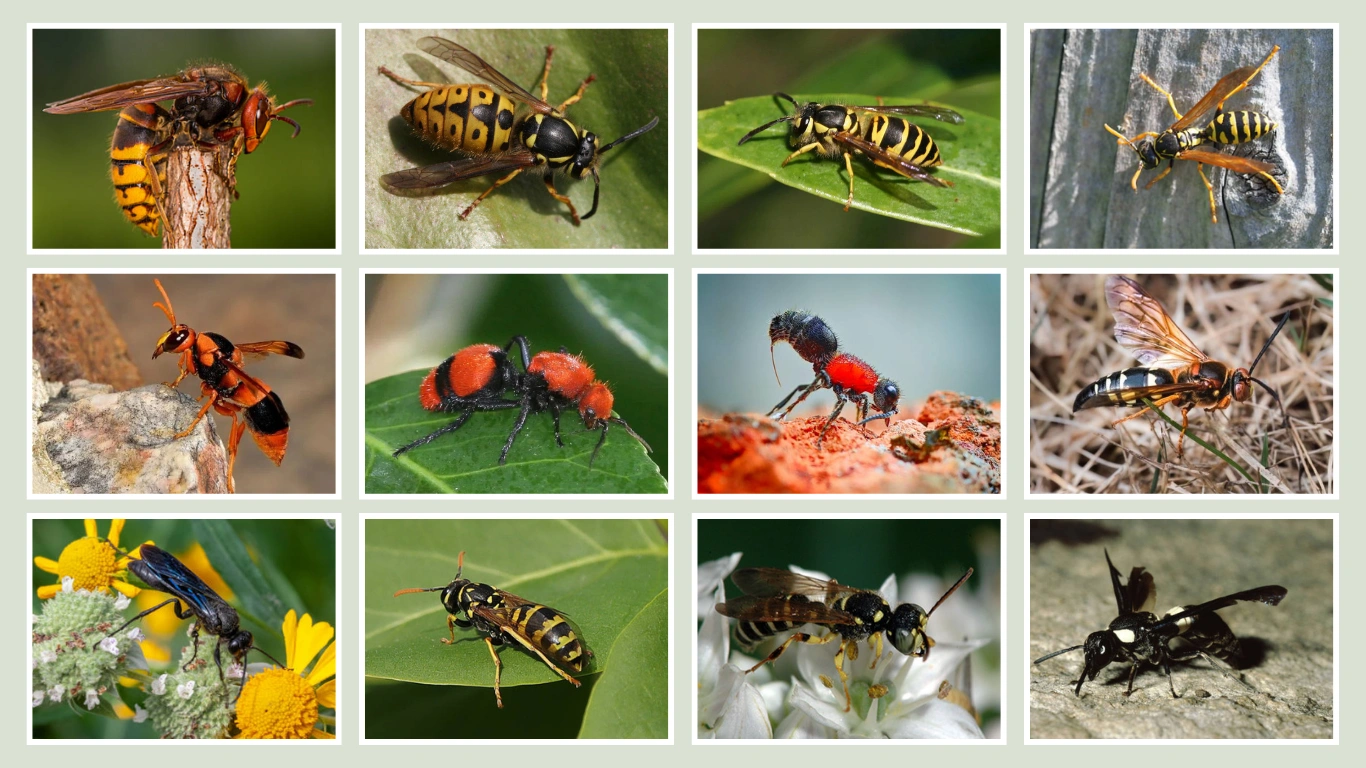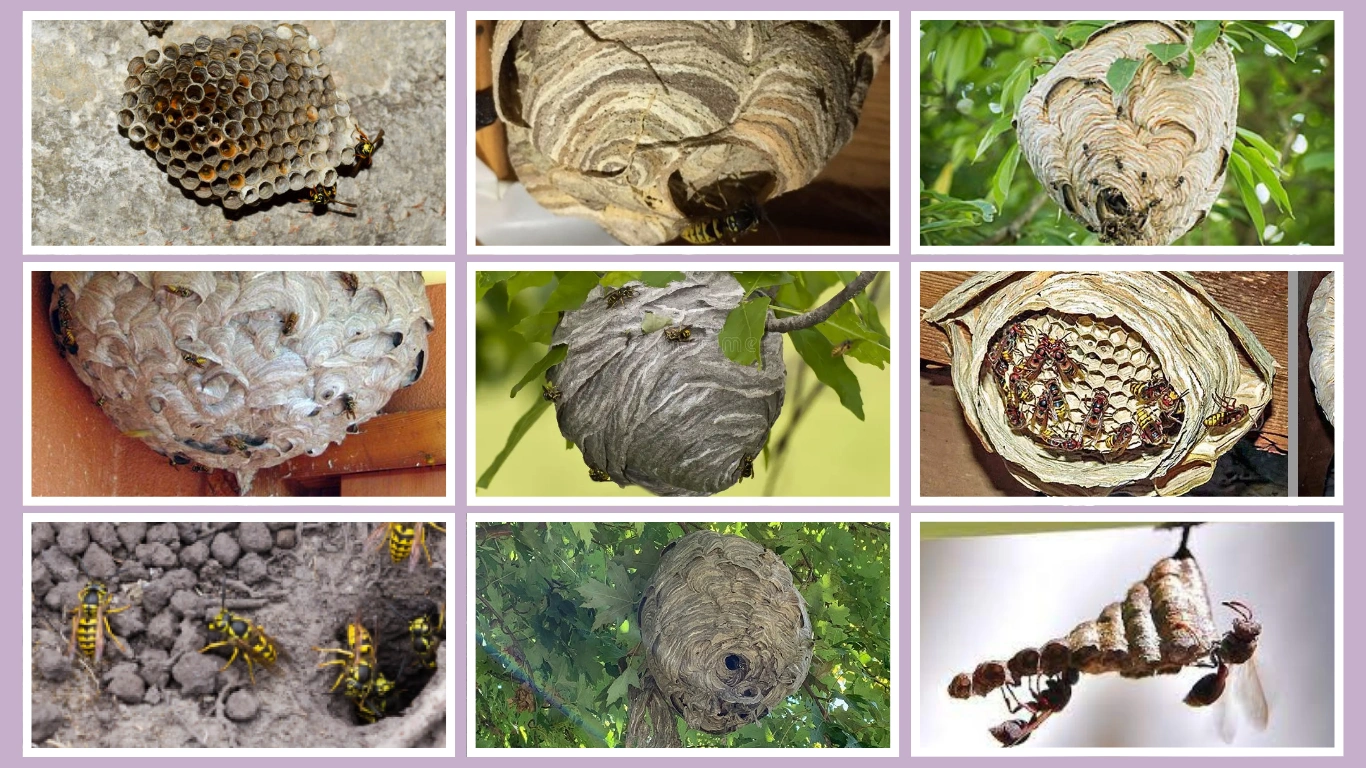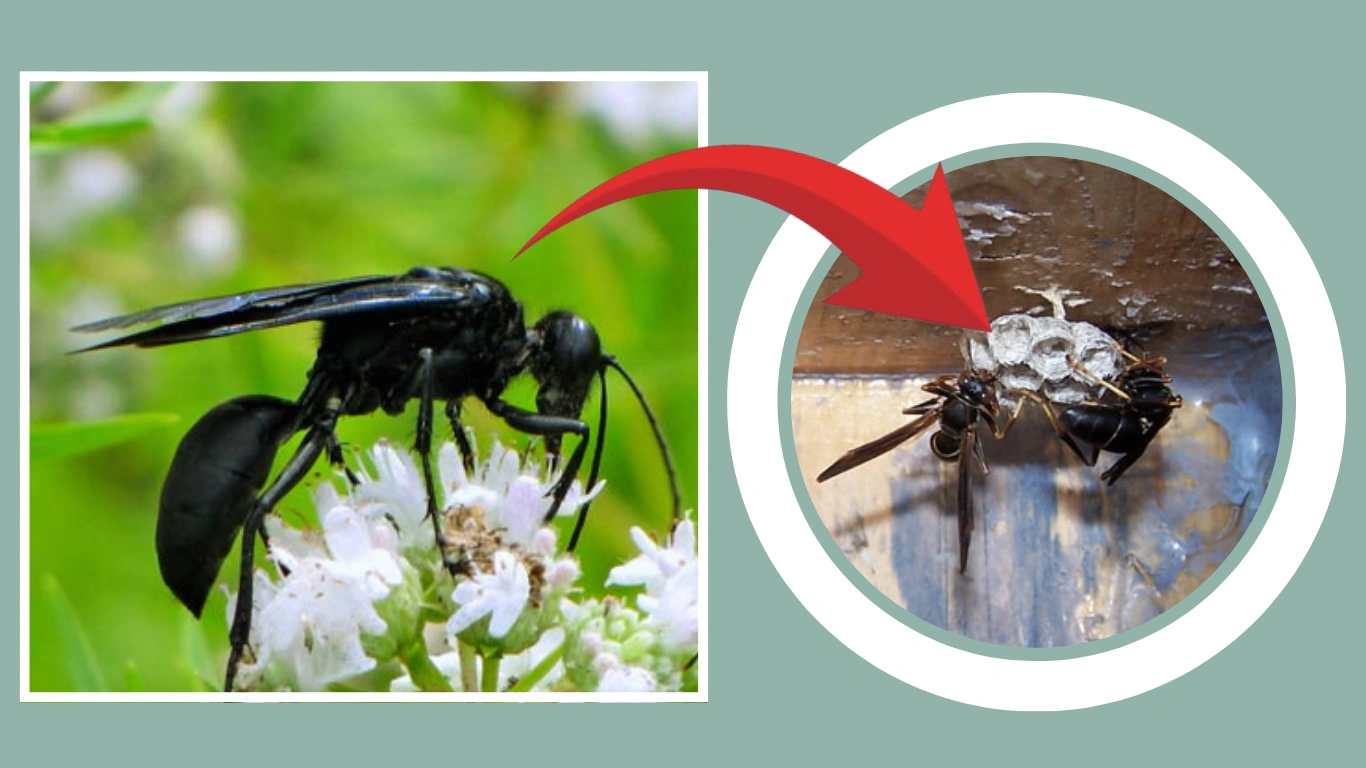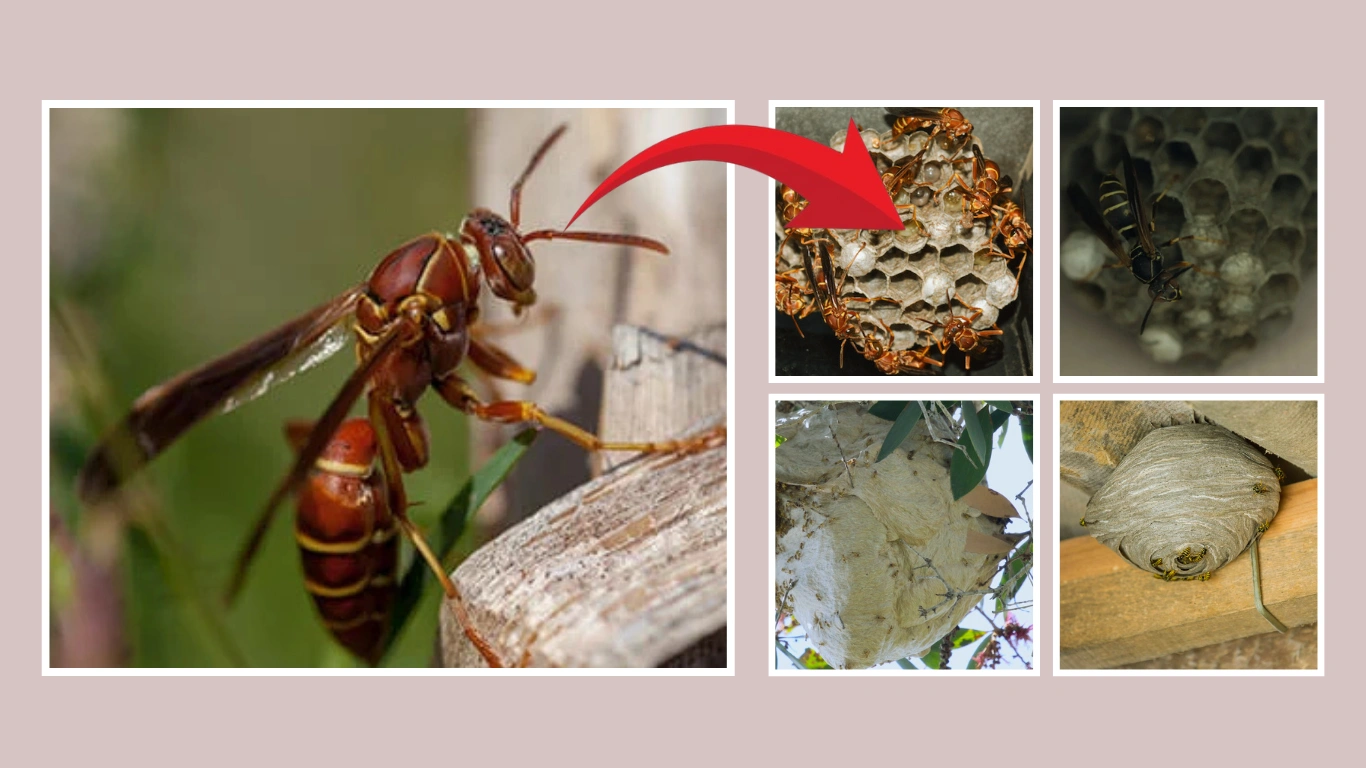Wasps are one of nature’s most diverse and fascinating insects—ranging from social stingers like hornets and yellowjackets to solitary hunters like tarantula hawks and mud daubers. With over 100,000 known species worldwide, wasps come in all sizes, colors, and temperaments. In this guide, I’ve covered 37 distinct types of wasps—each with identification tips, nesting habits, preferred habitats, and behavioral traits.
1. Hornets

Hornets are large, social wasps known for their size, powerful sting, and aggressive defense of their colonies. They play a vital ecological role by controlling pest insect populations. Hornets typically form aerial nests and are often mistaken for other wasps due to their coloration and size.
Identification
- Large and bulky body, typically 1.25 to 2 inches long
- Black, brown, or reddish body with yellow or white markings
- Thick abdomen and broad head with powerful jaws
- Prominent eyes and long antennae
- Loud, deep buzzing sound when flying
Nest
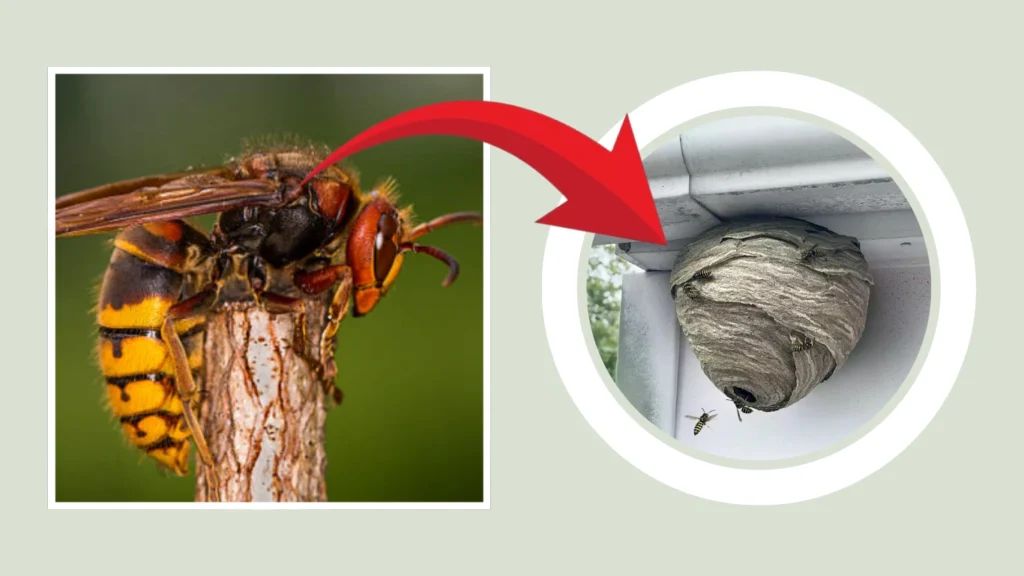
Hornets build their nests by chewing wood into a papery pulp. The nests are usually shaped like a football or sphere and are commonly found hanging from trees, shrubs, or under building eaves. A single nest can contain hundreds of workers at its peak.
Habitat
They prefer wooded areas, forest edges, and suburban gardens. Hornets often choose locations near food sources and water, nesting in protected places such as attics, tree canopies, and even wall cavities when indoors.
Behavior
Hornets are territorial and will aggressively defend their nest if they sense a threat. They are active hunters, feeding on flies, caterpillars, and other insects. While not typically aggressive toward humans unless provoked, their stings are painful and can cause allergic reactions in sensitive individuals.
Reproduction & Lifecycle
Each spring, a fertilized queen emerges from hibernation to start a new nest. She lays the first batch of eggs, which hatch into sterile female workers. By summer, the colony grows rapidly. In autumn, new queens and males are produced for mating. The original colony dies out in winter, with only the fertilized queens surviving until the next season.
2. Common Wasp
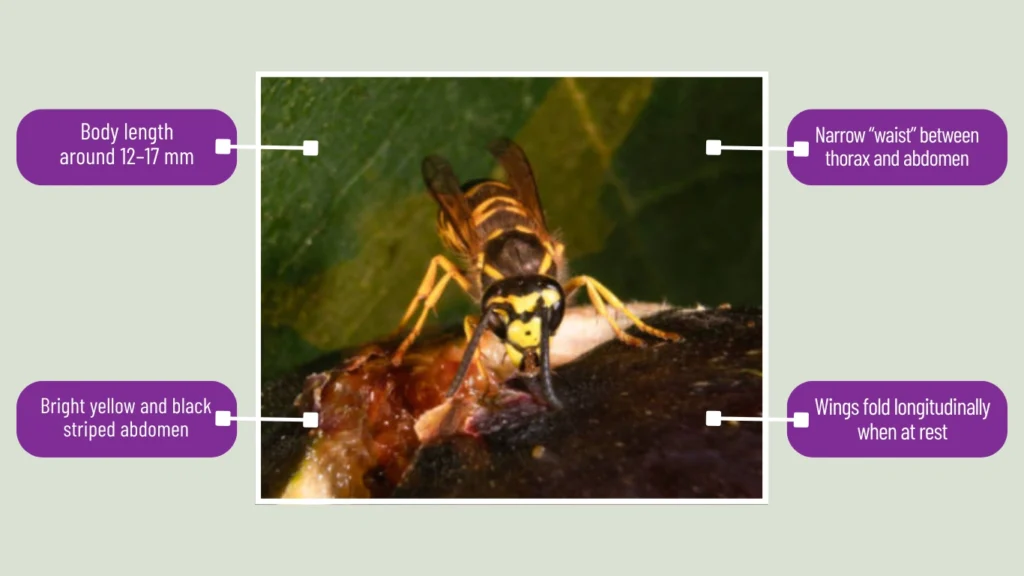
The common wasp (Vespula vulgaris) is one of the most frequently encountered wasps across Europe and parts of Asia. It is recognized for its vivid yellow and black bands and its tendency to become a nuisance in late summer when it scavenges for sugary foods. Despite their reputation, common wasps are valuable predators in gardens and ecosystems.
Identification
- Bright yellow and black striped abdomen
- Body length around 12–17 mm
- Narrow “waist” between thorax and abdomen
- Wings fold longitudinally when at rest
- Strong jaws and short antennae
Nest
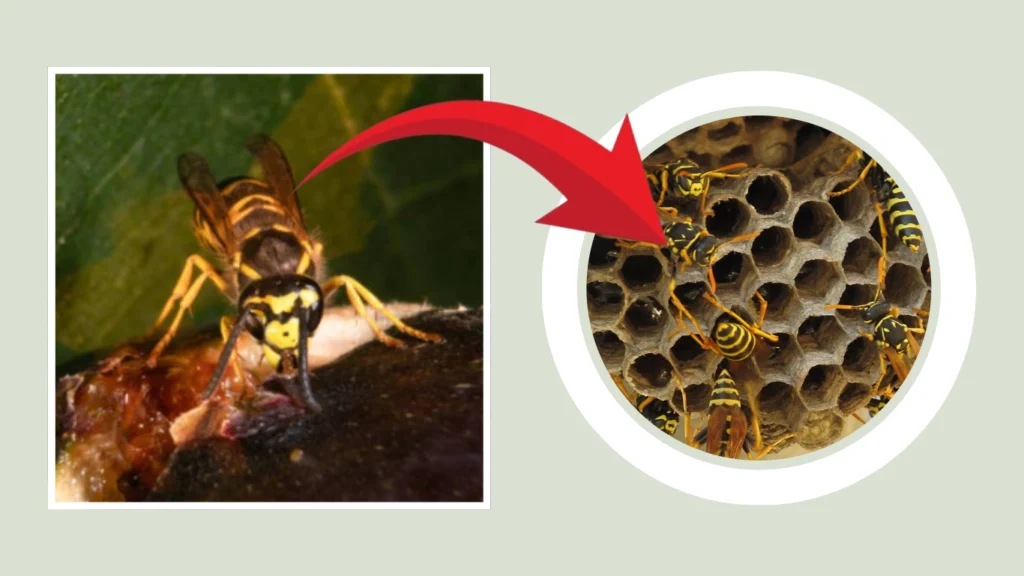
Common wasps build papery nests made from chewed wood fibers. These nests are usually underground or hidden in wall cavities, sheds, or roof spaces. Nests begin small in spring and can grow to house thousands of individuals by late summer.
Habitat
They adapt well to both natural and urban environments. Common habitats include woodlands, gardens, hedgerows, and human dwellings. They are especially attracted to food sources like compost bins and outdoor eating areas.
Behavior
Common wasps are social and live in large colonies with a strict caste system. They defend their nests aggressively. While they hunt insects for larvae, adults feed on nectar and sugary substances. They tend to become more aggressive in late summer due to changes in food behavior.
Reproduction & Lifecycle
A single queen starts the nest in spring and lays eggs continuously. Workers emerge and take over nest duties. In late summer, the colony produces new queens and males for reproduction. The colony dies in winter, with only the mated queens surviving to start new nests.
3. German Wasp
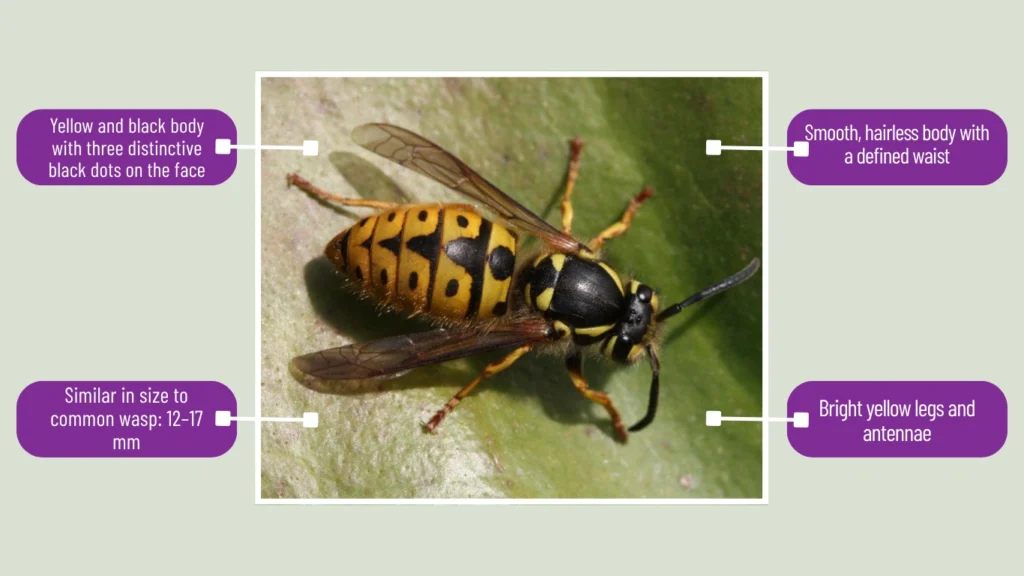
The German wasp (Vespula germanica) is a close relative of the common wasp but tends to be more widespread and invasive in some regions, including North America and Australia. It is a highly adaptable species and is known for its strong sting and defensive behavior.
Identification
- Yellow and black body with three distinctive black dots on the face
- Similar in size to common wasp: 12–17 mm
- Smooth, hairless body with a defined waist
- Translucent wings
- Bright yellow legs and antennae
Nest
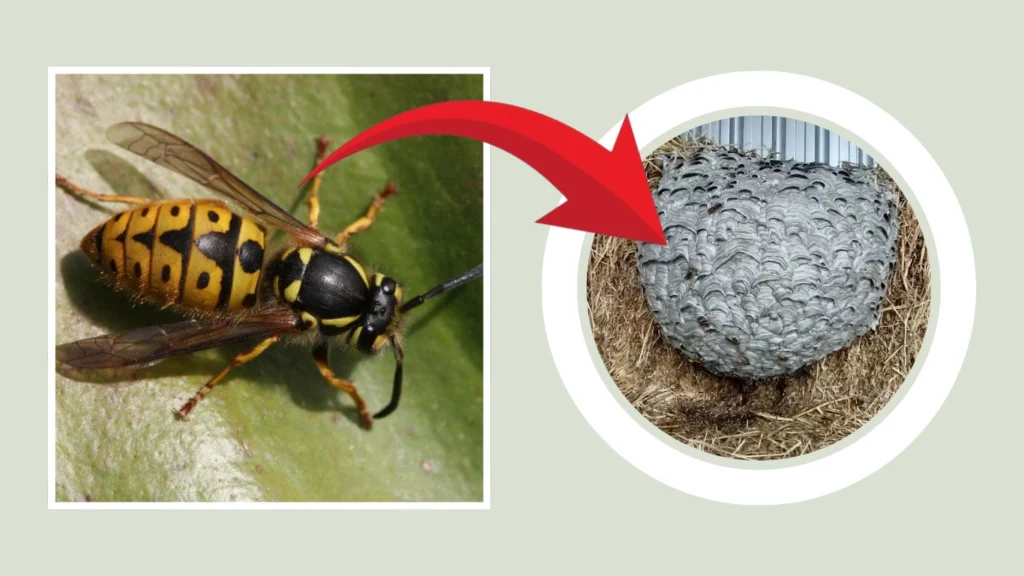
German wasps create large nests, often underground or inside buildings. Nests are constructed from a paper-like material made of wood pulp and saliva. They can house thousands of wasps and are typically built in sheltered, dry areas.
Habitat
This species thrives in both rural and urban environments. German wasps nest in tree hollows, wall cavities, underground burrows, and even abandoned rodent dens. Their flexibility allows them to adapt to various climates and regions.
Behavior
German wasps are more aggressive than many native wasps, especially when disturbed. They scavenge for proteins and sweets and will raid picnics or trash bins. Workers are effective hunters, feeding on other insects to nourish larvae.
Reproduction & Lifecycle
Like other social wasps, a single overwintered queen starts the colony. Workers hatch to support the queen’s egg-laying. By late summer, the nest produces reproductive males and new queens. The colony collapses in winter, and only fertilized queens survive for the next cycle.
4. Eastern Yellowjacket
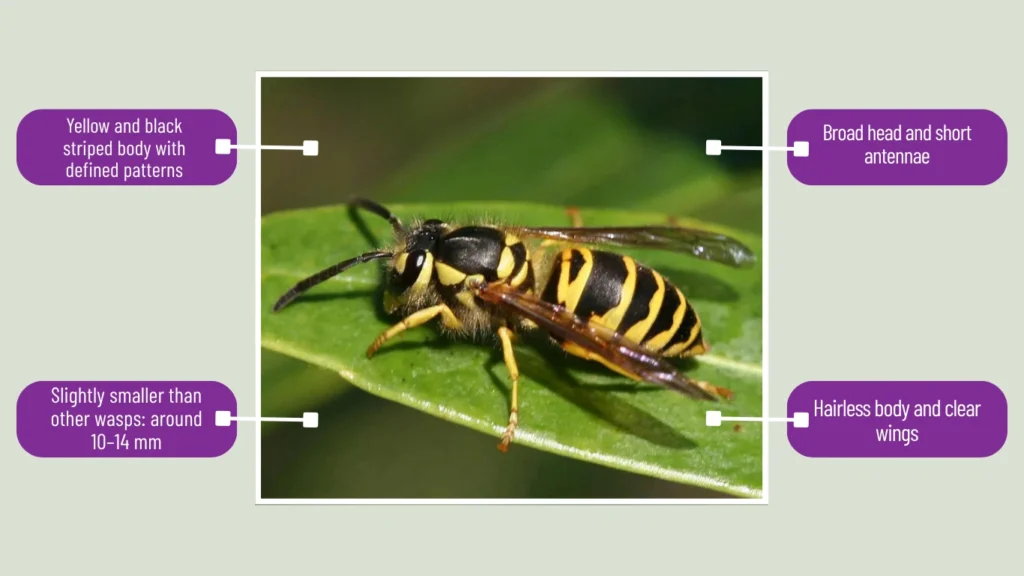
The Eastern yellowjacket (Vespula maculifrons) is a social wasp commonly found throughout eastern North America. It is easily recognized by its vivid black and yellow coloration and its aggressive defense of underground nests. These wasps are both beneficial predators and a stinging nuisance in populated areas.
Identification
- Yellow and black striped body with defined patterns
- Slightly smaller than other wasps: around 10–14 mm
- Broad head and short antennae
- Hairless body and clear wings
- Often confused with bees due to similar size
Nest
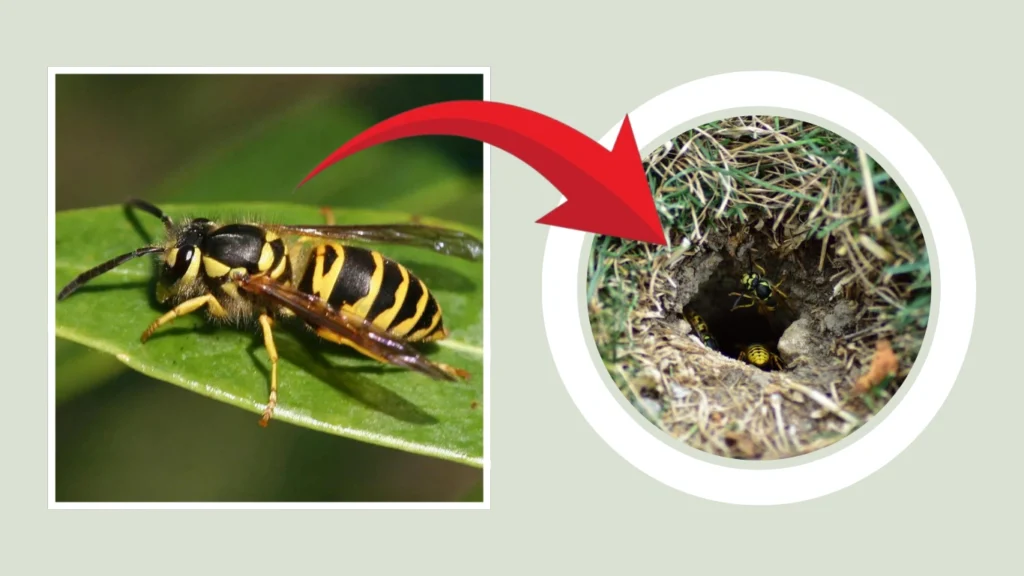
Eastern yellowjackets typically nest underground, often in abandoned rodent burrows or soil cavities. The nests are constructed from chewed wood pulp and can become very large, sometimes housing several thousand wasps by late summer.
Habitat
They are commonly found in grassy areas, parks, gardens, forest edges, and suburban lawns. Nests are usually hidden from plain sight, making accidental disturbances more likely.
Behavior
These wasps are extremely territorial and will sting repeatedly if their nest is threatened. Workers scavenge for sugary foods and proteins. They are attracted to picnic areas, trash cans, and barbecues, especially later in the season.
Reproduction & Lifecycle
In spring, a queen emerges from hibernation to start a new colony. Early brood becomes worker wasps. The colony peaks in summer, and new queens and males are produced in the fall. The colony dies in winter, with only the fertilized queens overwintering.
5. European Paper Wasp
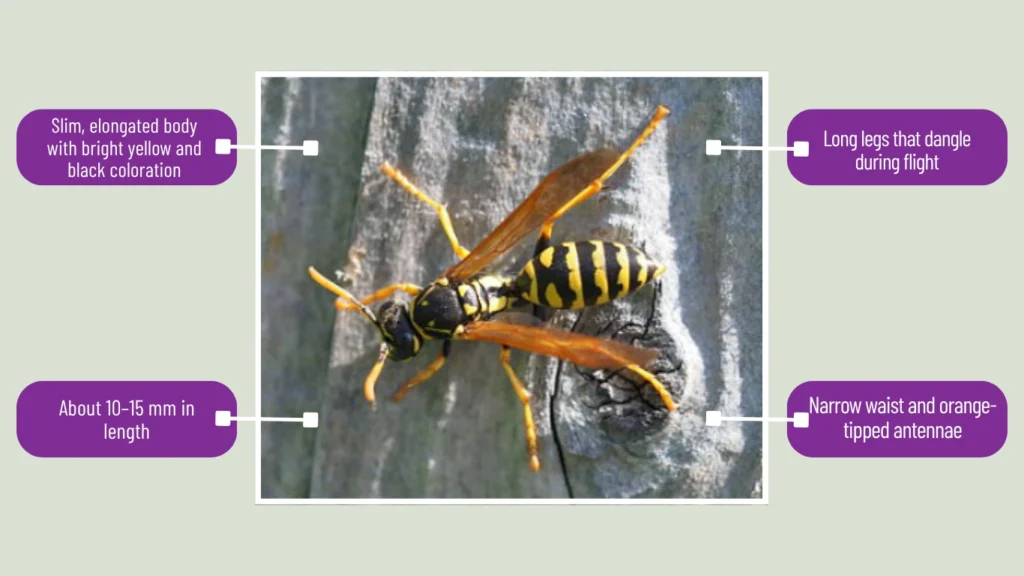
The European paper wasp (Polistes dominula) is a slender-bodied wasp native to Europe but now widely spread in North America and other continents. It is less aggressive than yellowjackets and plays an important ecological role by preying on garden pests.
Identification
- Slim, elongated body with bright yellow and black coloration
- About 10–15 mm in length
- Long legs that dangle during flight
- Narrow waist and orange-tipped antennae
- Sometimes mistaken for a yellowjacket but more slender
Nest
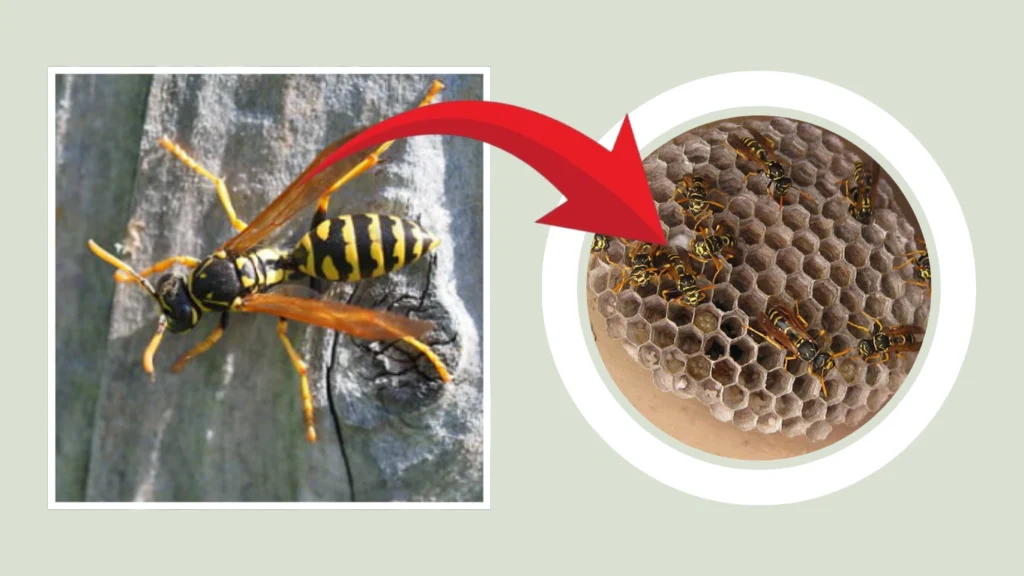
These wasps build open, umbrella-shaped nests under eaves, in vents, or on sheltered tree branches. The nests are made from a paper-like material and contain visible hexagonal cells, which are not covered by an outer shell like hornet nests.
Habitat
European paper wasps adapt well to urban, suburban, and rural areas. They prefer warm, dry environments and often nest around buildings, fences, and outdoor furniture.
Behavior
They are less aggressive than other wasps unless provoked. Workers forage for caterpillars and other insects to feed the larvae. Adults also consume nectar and sugary substances. They are beneficial in gardens due to their pest control habits.
Reproduction & Lifecycle
A single queen begins nest construction in early spring. After the first brood of workers matures, they help expand the nest. New reproductive males and females appear in late summer. The colony disbands in winter, with only fertilized females surviving to form new nests.
6. Australian Hornet
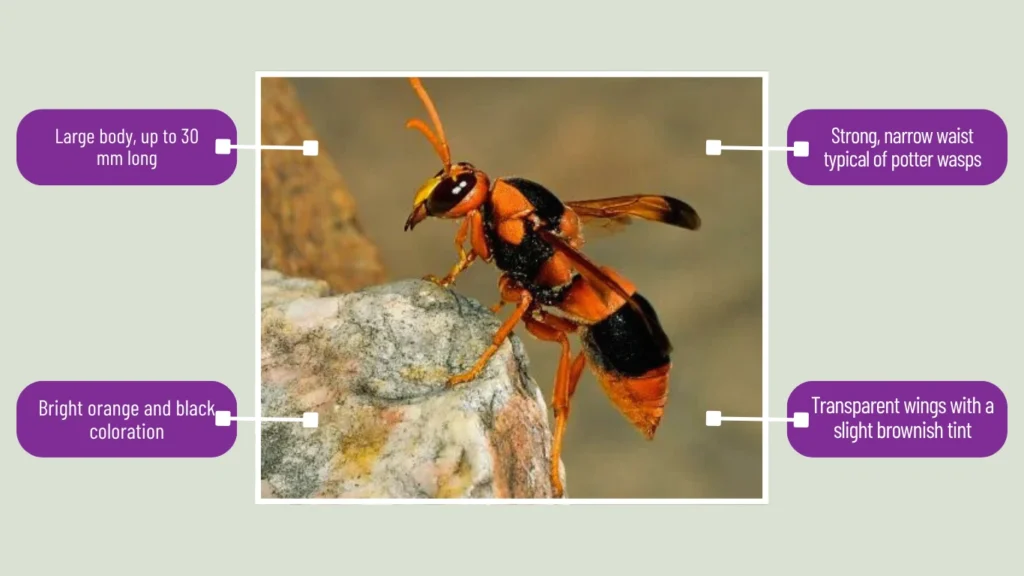
Despite its name, the Australian hornet (Abispa ephippium) is actually a type of large solitary potter wasp. Found primarily in Australia, this striking wasp is known for its vibrant coloration and impressive clay nests.
Identification
- Large body, up to 30 mm long
- Bright orange and black coloration
- Strong, narrow waist typical of potter wasps
- Transparent wings with a slight brownish tint
- Bold and intimidating in appearance
Nest
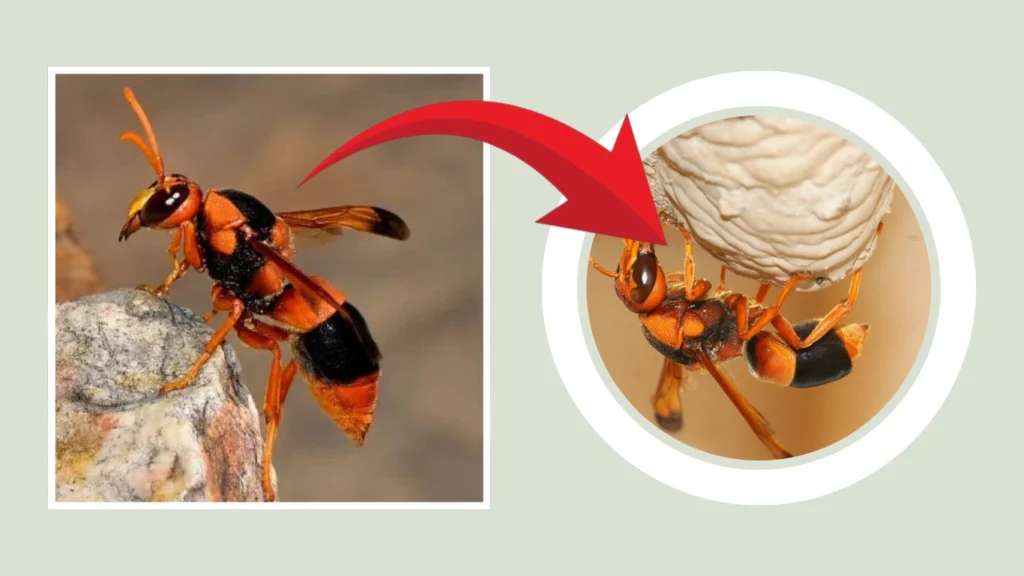
Australian hornets construct solitary mud nests that are often attached to tree trunks, walls, or even furniture. These clay nests have a pot-like shape and are divided into compartments, each containing a single egg and a paralyzed insect for the larva to feed on.
Habitat
They are commonly seen in gardens, forests, and suburban areas throughout Australia. They prefer sunny, dry spots to build their nests and are often spotted resting on walls or wooden surfaces.
Behavior
These wasps are solitary and generally non-aggressive toward humans unless provoked. They are skilled hunters, paralyzing caterpillars and other insects to feed their young. Adults feed on nectar and are most active during the warmer months.
Reproduction & Lifecycle
Females work alone to build nests and provision each cell with food. After laying an egg in a cell, they seal it and move on to build the next one. The larva feeds on the provided prey and pupates within the nest. Adults emerge to continue the cycle.
7. Velvet Ants
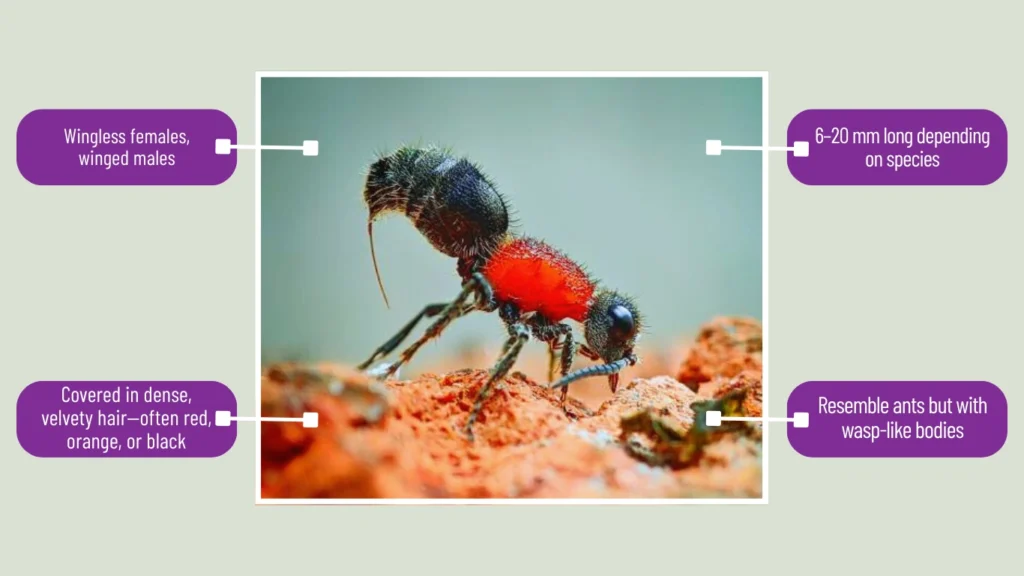
Velvet ants, often referred to as “cow killers,” are actually wasps from the family Mutillidae. The females are wingless and resemble large, hairy ants. They are known for their intense sting and bright warning colors.
Identification
- Wingless females, winged males
- Covered in dense, velvety hair—often red, orange, or black
- 6–20 mm long depending on species
- Resemble ants but with wasp-like bodies
- Extremely fast-moving and hard-bodied
Nest
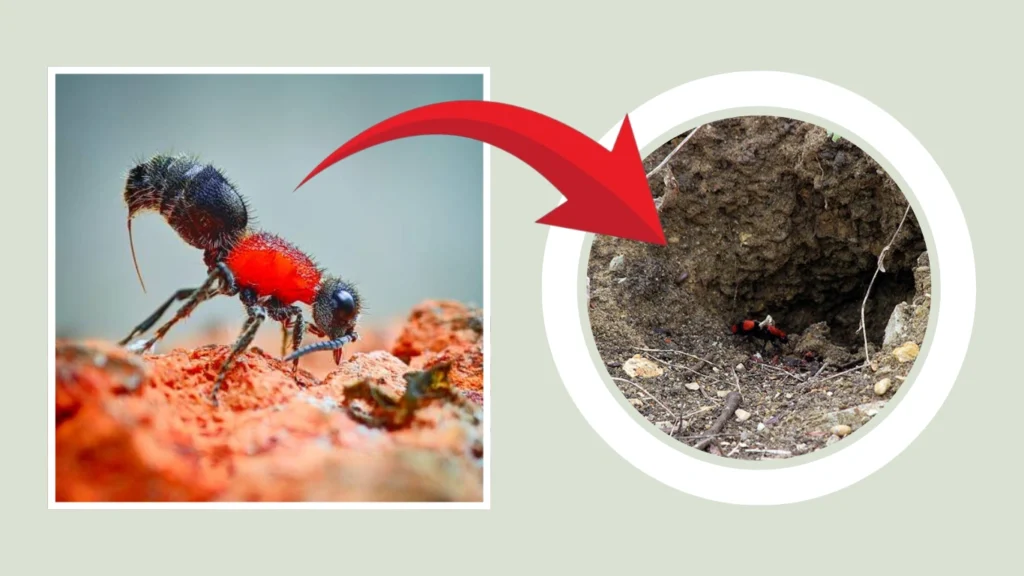
Velvet ants do not build their own nests. Instead, females invade the nests of other ground-dwelling bees or wasps, where they lay their eggs. The developing velvet ant larva feeds on the host’s larva and stored food.
Habitat
They are found in dry, sandy environments like deserts, fields, and scrublands. Velvet ants are often seen wandering alone in open, sunny areas during the day.
Behavior
Females are solitary and capable of delivering a very painful sting. They are also known for their squeaky warning sounds. Despite their name, they do not typically attack unless handled. Males fly in search of mates but do not sting.
Reproduction & Lifecycle
A female seeks out host nests to lay her eggs. Her larvae act as parasitoids, developing by consuming the host larva. After pupation, the adult emerges and begins the cycle again. The lifecycle is entirely solitary, with no colony structure.
8. Cicada Killer Wasps
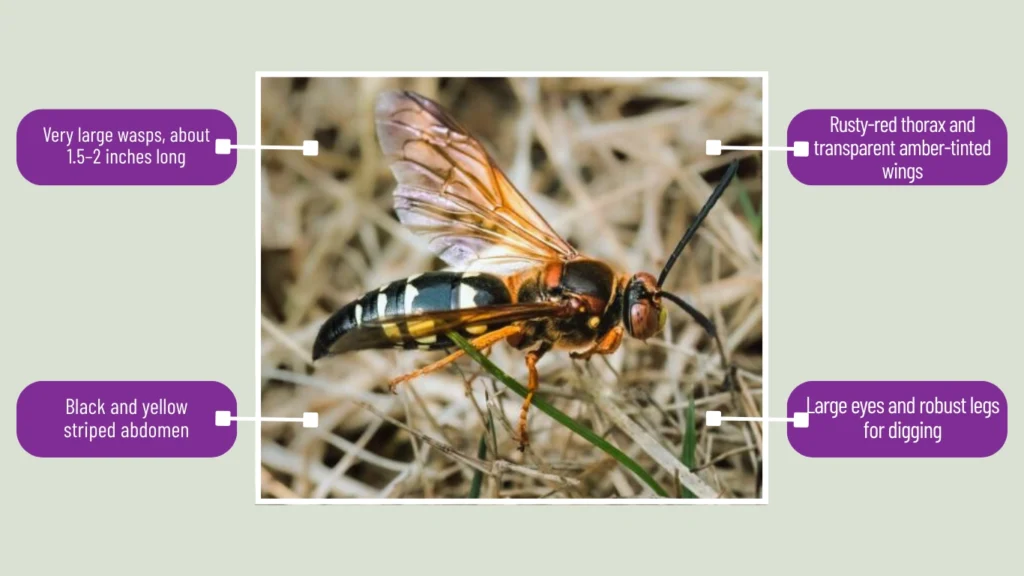
Cicada killer wasps (Sphecius speciosus) are large, solitary wasps known for their impressive size and unique hunting behavior. Despite their intimidating appearance, they are not aggressive toward humans and are beneficial predators of cicadas.
Identification
- Very large wasps, about 1.5–2 inches long
- Black and yellow striped abdomen
- Rusty-red thorax and transparent amber-tinted wings
- Large eyes and robust legs for digging
- Often mistaken for hornets but more solitary in behavior
Nest
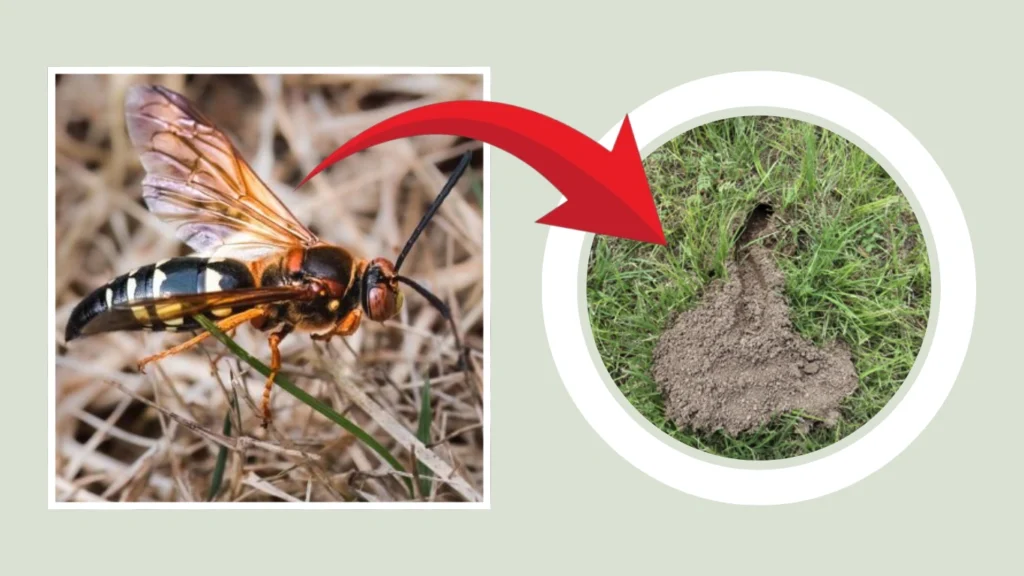
Cicada killers dig burrows in sandy or loose soil. Each female creates a tunnel with multiple chambers, each containing a single paralyzed cicada and one egg. These burrows may be found in lawns, gardens, or along sidewalks.
Habitat
They prefer dry, well-drained soil in open, sunny areas. Common habitats include playgrounds, gardens, sandy banks, and even golf courses. They often return to the same area each year to nest.
Behavior
Females are solitary hunters, capturing cicadas mid-flight and dragging them into their burrows. They are non-aggressive and rarely sting unless handled. Males are territorial but cannot sting; they often confront humans but pose no danger.
Reproduction & Lifecycle
After catching a cicada, the female lays an egg on it and seals it inside a burrow chamber. The larva hatches, feeds on the cicada, and pupates. It overwinters in the soil and emerges the following summer as an adult to repeat the cycle.
9. Red Velvet Ant
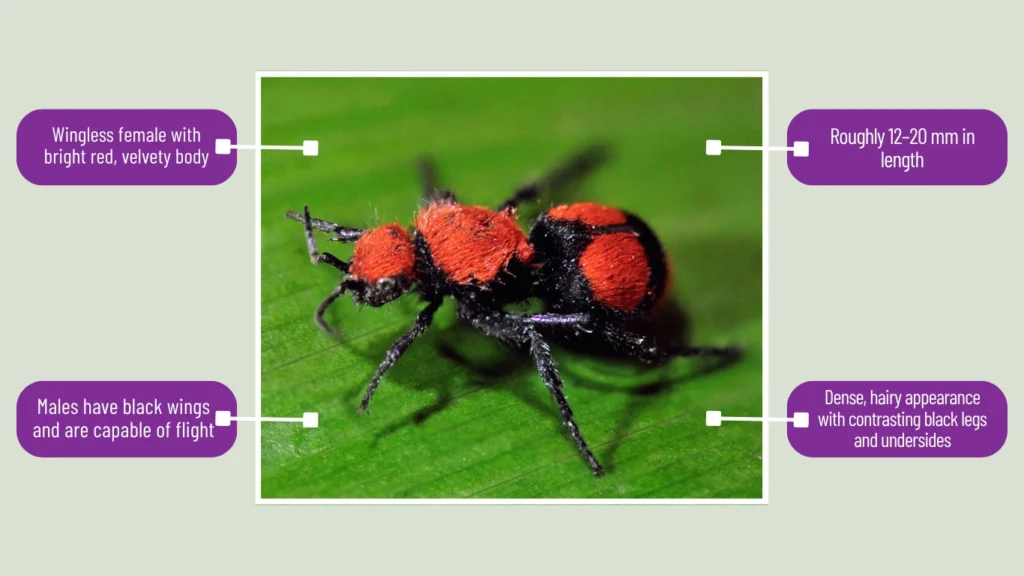
The red velvet ant (Dasymutilla occidentalis) is actually a wingless female wasp of the Mutillidae family. Commonly known as the “cow killer,” it is famous for its bright red coloration and one of the most painful stings among wasps.
Identification
- Wingless female with bright red, velvety body
- Males have black wings and are capable of flight
- Roughly 12–20 mm in length
- Dense, hairy appearance with contrasting black legs and undersides
- Tough exoskeleton and quick movements
Nest

Red velvet ants do not build their own nests. Females invade the nests of ground-dwelling bees or wasps and lay their eggs inside. The larvae act as parasites, consuming the host’s offspring or stored food.
Habitat
They prefer dry, sandy, or grassy areas like fields, meadows, and forest edges. Females are often seen scurrying alone on the ground during warm months, especially in the southeastern United States.
Behavior
Though solitary and not aggressive, females will sting if disturbed or handled. Their sting is extremely painful, which is why they earned the nickname “cow killer.” Males are harmless and often mistaken for different species due to their wings.
Reproduction & Lifecycle
The female lays her eggs in the brood chambers of host wasps or bees. The developing larva feeds internally or externally on the host larva. Adults are solitary, and no colony is formed. Mating occurs above ground, often near host nest areas.
10. Chalybion californicum
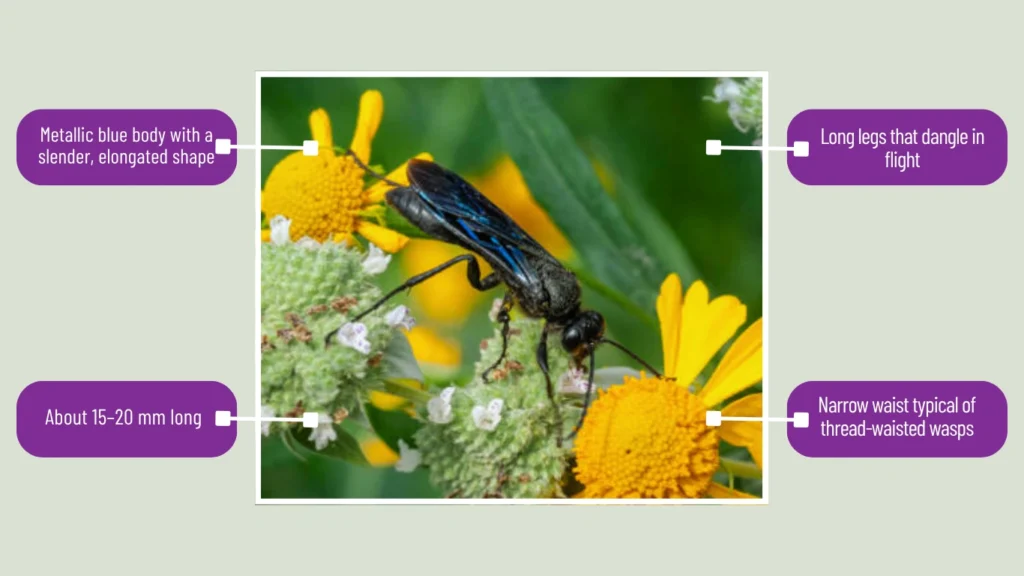
Also known as the blue mud dauber, Chalybion californicum is a solitary wasp recognized for its metallic blue body and role in controlling spider populations. It is non-aggressive and often nests near human dwellings.
Identification
- Metallic blue body with a slender, elongated shape
- About 15–20 mm long
- Long legs that dangle in flight
- Narrow waist typical of thread-waisted wasps
- Shiny and hairless exoskeleton
Nest
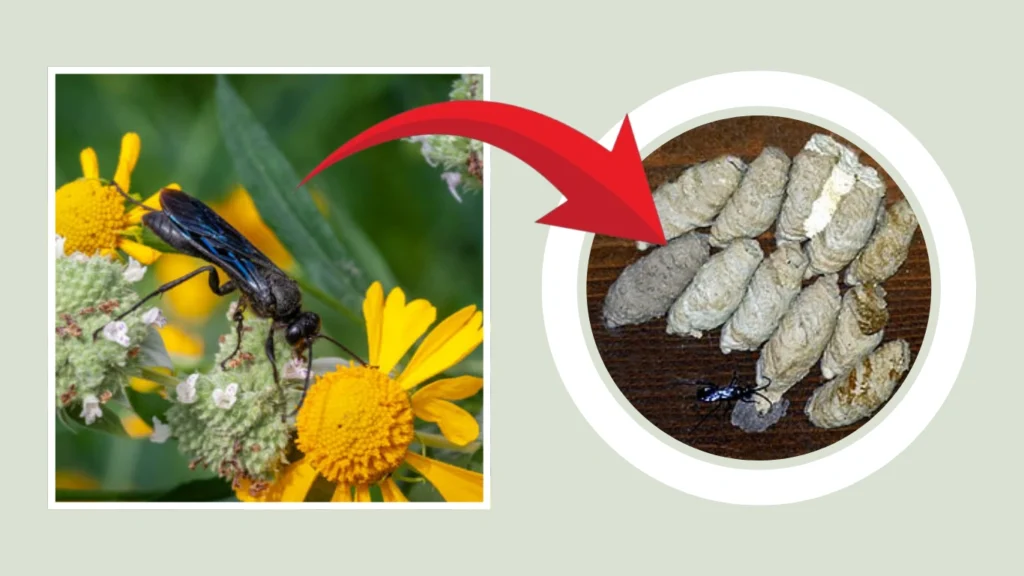
Chalybion californicum usually takes over old nests of black and yellow mud daubers, modifying or repairing them. The female fills the nest cells with paralyzed spiders before laying eggs. The sealed mud tubes are attached to walls, ceilings, or rock surfaces.
Habitat
These wasps thrive in both natural and urban settings. They prefer warm environments and are commonly found in barns, sheds, attics, and under eaves. They are especially attracted to areas with spider populations.
Behavior
They are solitary and rarely sting humans. Females hunt spiders, paralyze them, and transport them back to the nest as food for their larvae. Adults feed on nectar and are important pollinators. Their flight is smooth and silent, unlike buzzing wasps.
Reproduction & Lifecycle
The female lays an egg on each spider she stores in a mud cell. Once hatched, the larva feeds on the spider before pupating. Adults emerge after development, often in late spring or summer. One or more generations may occur annually depending on the climate.
11. Polistes
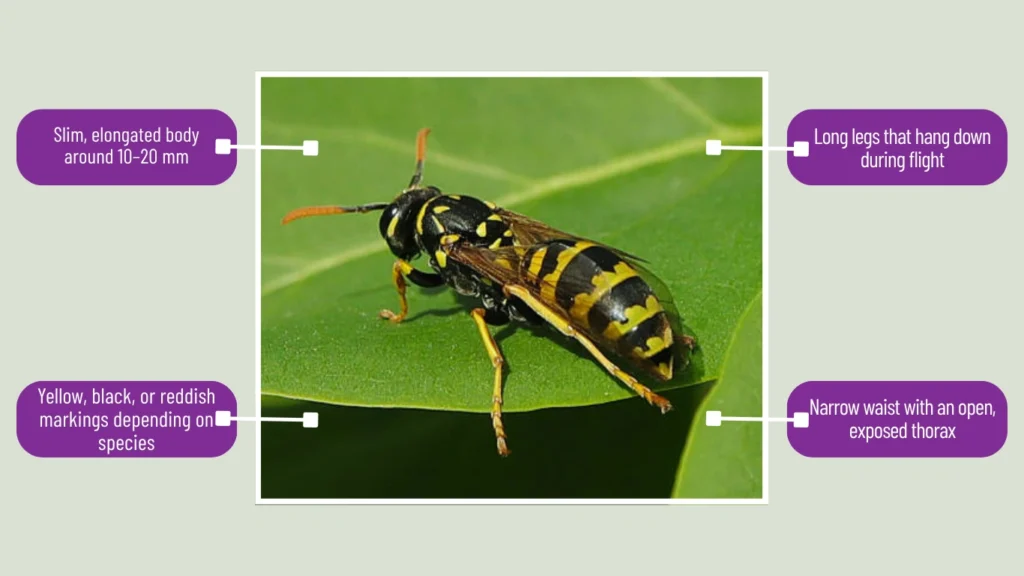
Polistes, commonly known as paper wasps, are a genus of social wasps known for their open comb nests and helpful role in pest control. They are less aggressive than yellowjackets and hornets but will defend their nest if threatened.
Identification
- Slim, elongated body around 10–20 mm
- Yellow, black, or reddish markings depending on species
- Long legs that hang down during flight
- Narrow waist with an open, exposed thorax
- Antennae are often orange-tipped
Nest
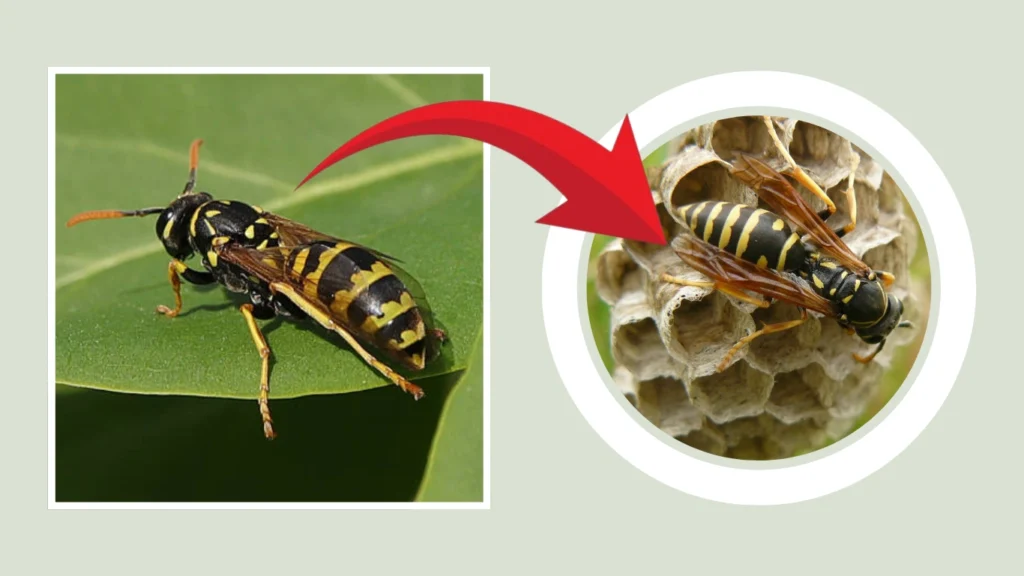
Polistes build open, umbrella-shaped nests made from chewed plant fibers and saliva. The nests are attached by a single stalk and contain visible hexagonal cells. They are usually found under eaves, window frames, porch ceilings, or tree branches.
Habitat
They prefer sheltered spots in both natural and built environments. Nests are often located in gardens, barns, garages, and under roof overhangs. Polistes are especially common in warm and temperate regions worldwide.
Behavior
Polistes are semi-aggressive—generally calm unless their nest is disturbed. They prey on caterpillars and other soft-bodied insects, making them beneficial to gardeners. Adults feed on nectar and sugary substances and are frequently seen on flowers.
Reproduction & Lifecycle
A queen starts a new nest in spring and lays eggs in the cells. Once the first brood matures, they become sterile female workers. Later in the season, males and new queens are produced. The original colony dies in winter, with only fertilized queens overwintering.
12. Pepsis
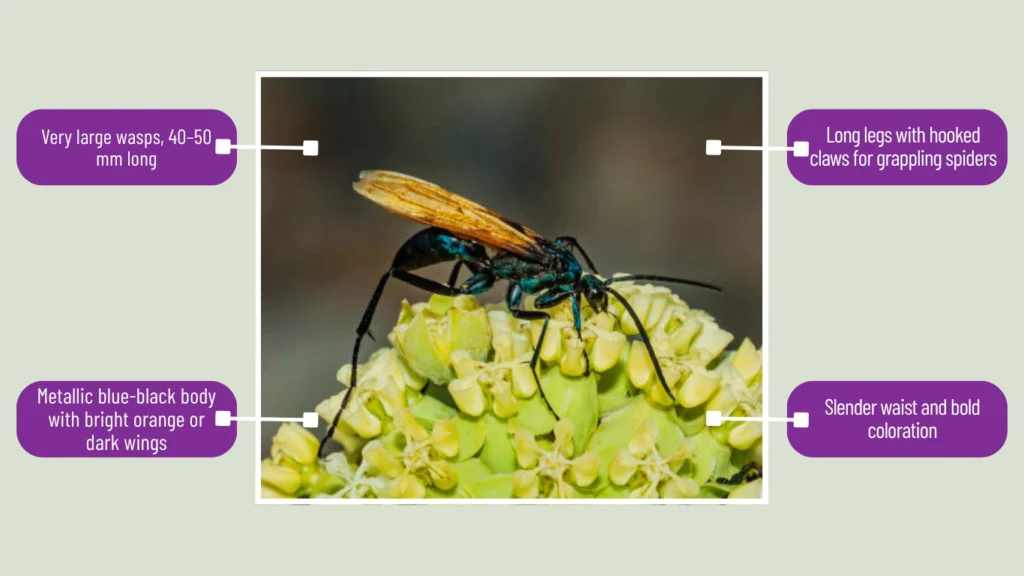
Pepsis is a genus of large, solitary wasps commonly referred to as tarantula hawks due to their specialization in hunting tarantulas. Known for having one of the most painful stings in the insect world, these wasps are striking in both appearance and behavior.
Identification
- Very large wasps, 40–50 mm long
- Metallic blue-black body with bright orange or dark wings
- Long legs with hooked claws for grappling spiders
- Slender waist and bold coloration
- Noticeable and intimidating due to size and flight
Nest
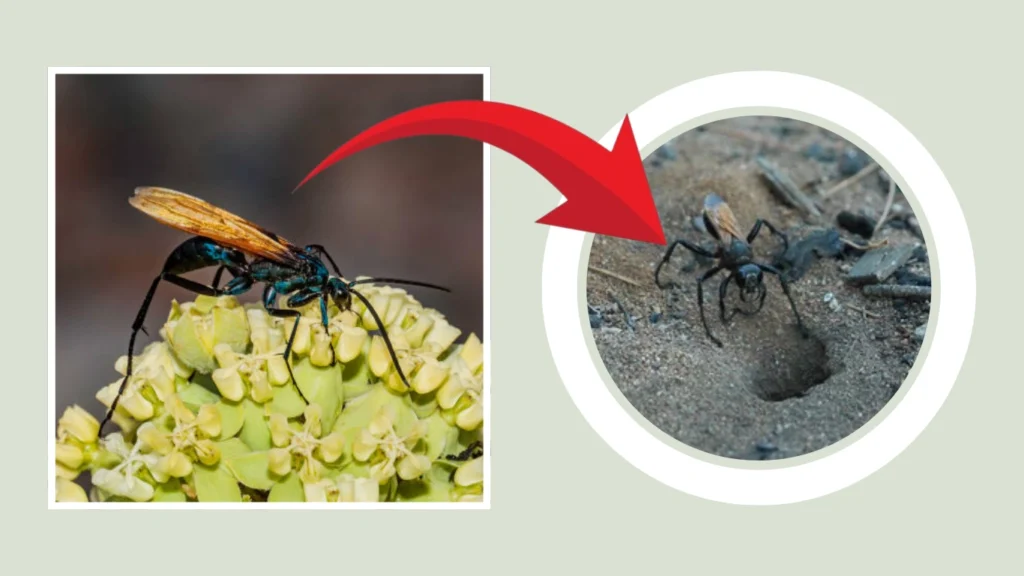
Pepsis wasps do not build traditional nests. After paralyzing a tarantula, the female drags it into a specially dug burrow, lays an egg on it, and seals the entrance. The developing larva feeds on the still-living spider.
Habitat
They are mostly found in arid, desert, and scrubland regions across the Americas. These wasps prefer warm climates and are often seen flying low to the ground while searching for tarantulas or nectar sources.
Behavior
Despite their painful sting, Pepsis wasps are not aggressive and rarely sting unless handled. Females hunt tarantulas with incredible precision. Adults feed on nectar and are especially attracted to milkweed and mesquite flowers.
Reproduction & Lifecycle
The female lays a single egg on a paralyzed tarantula. The larva hatches and consumes the spider slowly, avoiding vital organs until the final stage. After pupation inside the burrow, the adult emerges, continuing the life cycle. Only one generation is produced per year.
13. Solitary Wasp
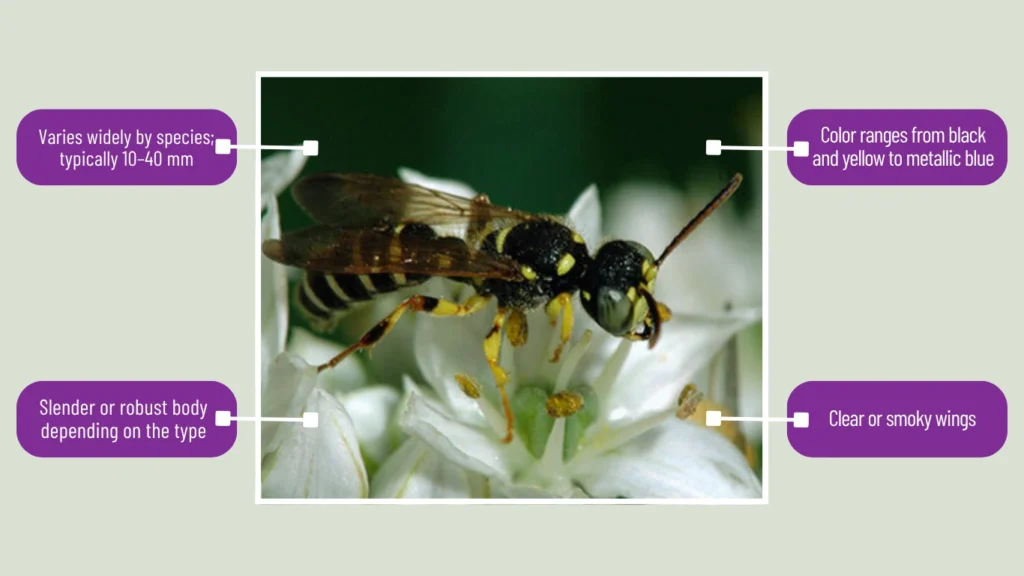
“Solitary wasp” refers to a wide variety of non-social wasps that do not live in colonies. These wasps typically work alone, building their own nests and hunting for prey to provide for their offspring. Many species fall under this category, including mud daubers, spider wasps, and potter wasps.
Identification
- Varies widely by species; typically 10–40 mm
- Slender or robust body depending on the type
- Color ranges from black and yellow to metallic blue
- Clear or smoky wings
- Often seen alone rather than in groups
Nest
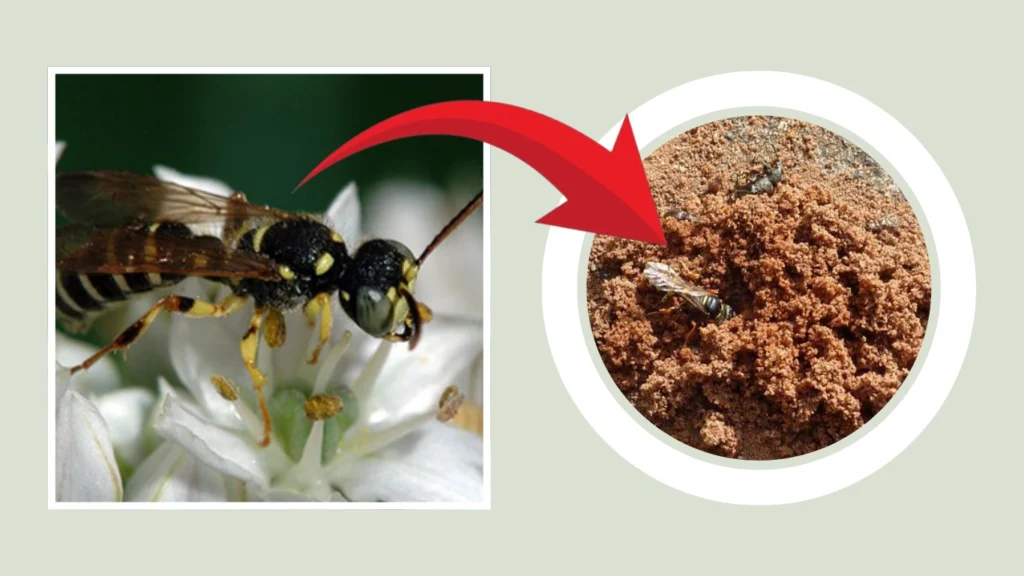
Solitary wasps build nests using mud, plant fibers, or by digging tunnels in the ground. Each nest is provisioned with paralyzed prey and sealed. Some species reuse abandoned nests or natural cavities.
Habitat
Found in nearly every type of environment—gardens, forests, fields, deserts, and urban areas. They prefer areas with accessible nesting materials and abundant insect prey.
Behavior
Solitary wasps are not aggressive and rarely sting unless provoked. They are important pest controllers, targeting caterpillars, spiders, or beetle larvae depending on species. They do not form colonies and lead independent lives.
Reproduction & Lifecycle
Each female independently builds a nest, paralyzes prey, and lays a single egg. The larva feeds on the stored prey and pupates within the nest. Adult wasps emerge and repeat the process. No worker caste or colony structure exists in solitary wasps.
14. Vespula
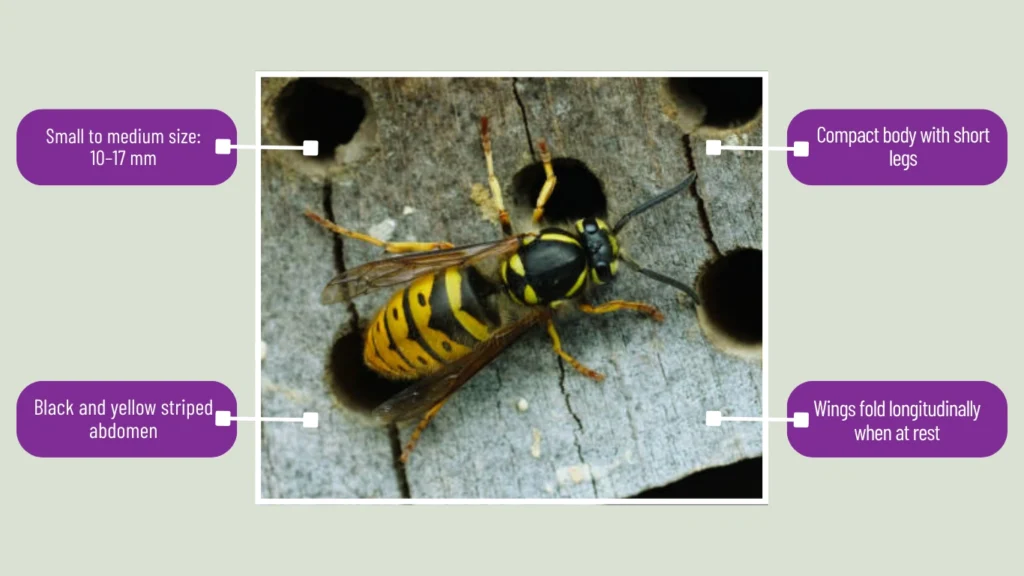
Vespula is a genus of social wasps that includes several well-known species such as the common wasp and German wasp. These wasps are recognized for their aggressive nest defense and close association with human environments.
Identification
- Small to medium size: 10–17 mm
- Black and yellow striped abdomen
- Compact body with short legs
- Wings fold longitudinally when at rest
- Three black dots often visible on the face in some species
Nest

Vespula species create paper nests from chewed wood pulp, often located underground, in tree hollows, or within manmade structures. The nests can grow quite large and are typically spherical with internal chambers to house larvae and food storage.
Habitat
These wasps are highly adaptable and found across North America, Europe, and parts of Asia. They nest in gardens, fields, roof spaces, and sometimes inside walls or sheds. Vespula wasps thrive in both wild and urban environments.
Behavior
Vespula wasps are aggressive defenders of their nests. They forage for sugary substances and protein-rich foods and are often seen scavenging at picnics or trash bins. Their stings are painful and can be delivered multiple times.
Reproduction & Lifecycle
In spring, a queen emerges from hibernation and starts a nest. She lays eggs that hatch into workers who expand the colony. In late summer, the colony produces new queens and males. By winter, the colony dies out except for fertilized queens.
15. Organ Pipe Mud Dauber
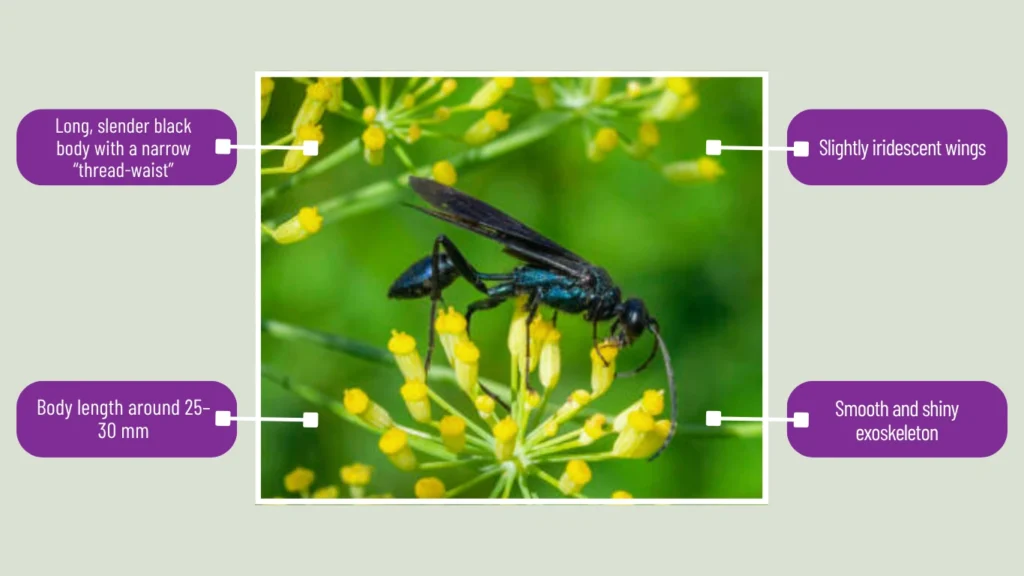
The organ pipe mud dauber (Trypoxylon politum) is a solitary wasp named for the unique, tubular shape of its mud nests. It is harmless to humans and plays a useful role in spider population control.
Identification
- Long, slender black body with a narrow “thread-waist”
- Body length around 25–30 mm
- Slightly iridescent wings
- Smooth and shiny exoskeleton
- Graceful flight pattern and solitary activity
Nest
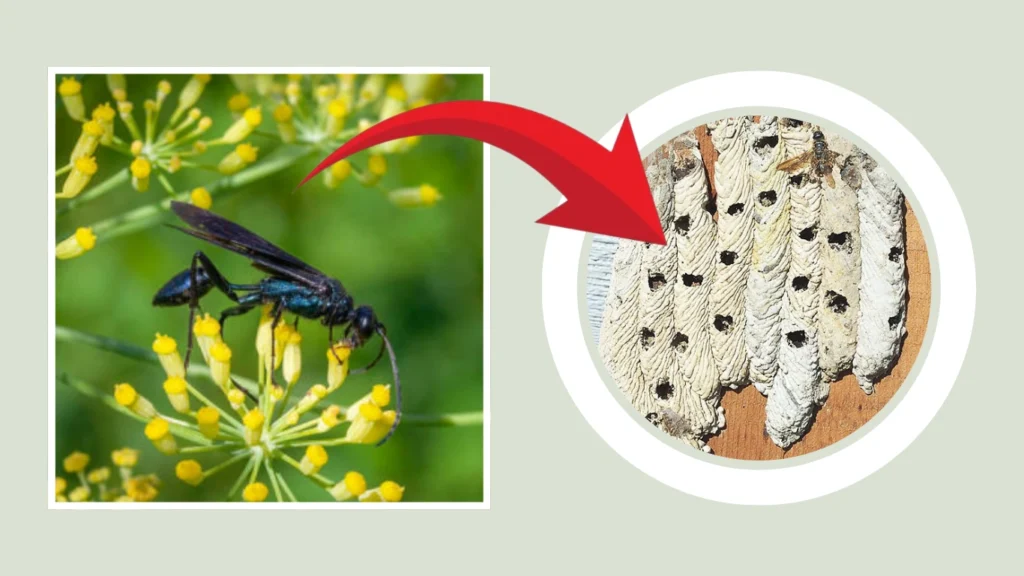
This species builds distinctive vertical rows of cylindrical mud tubes resembling organ pipes, usually attached to walls, ceilings, or sheltered rock surfaces. Each tube is filled with paralyzed spiders and sealed after an egg is laid.
Habitat
Found throughout the eastern and southern United States, they prefer sheltered structures such as barns, attics, garages, and under bridges. They seek out spots protected from rain and direct sunlight for nest construction.
Behavior
Organ pipe mud daubers are not aggressive and rarely sting. Females capture and paralyze spiders to feed their larvae. Adults feed on nectar and water. They tend to ignore human activity unless disturbed during nesting.
Reproduction & Lifecycle
A female constructs mud tubes and fills each chamber with spiders and a single egg. The larva consumes the spiders, then pupates inside the chamber. The adult emerges by chewing through the mud seal. One or two generations occur per year depending on climate.
16. Andricus quercuscalicis

Andricus quercuscalicis, also known as the knopper gall wasp, is a small parasitic wasp that induces galls on oak trees. Though tiny and rarely noticed, these wasps play a significant ecological role in oak woodland ecosystems.
Identification
- Very small, typically around 2–3 mm in length
- Brown or black body with clear wings
- Slender Slender antennae
- Often mistaken for other gall wasps due to size
- Visible mostly through the galls they create on oak acorns
Nest
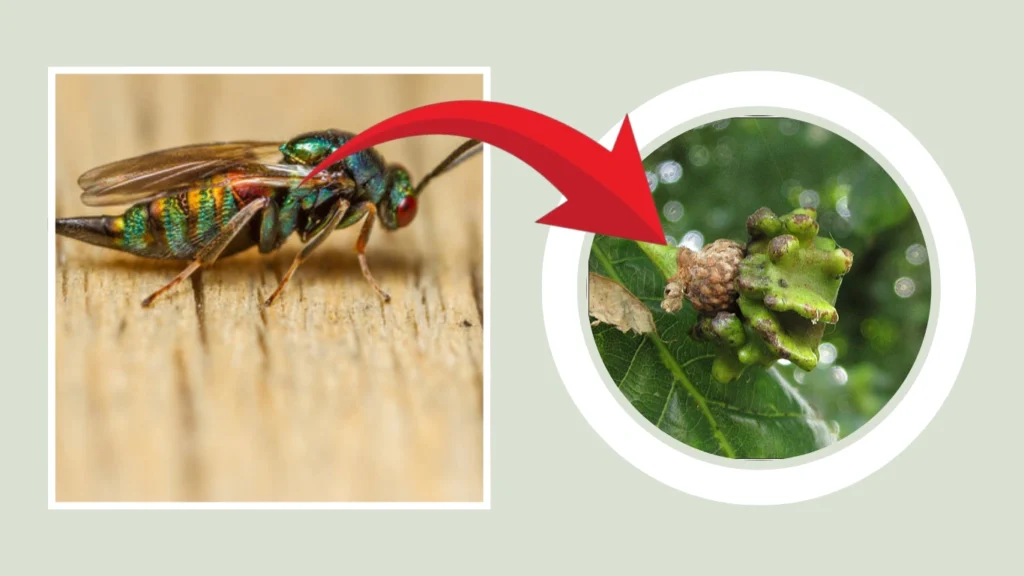
This species does not build traditional nests. Instead, females lay eggs in the developing acorns of oak trees. The larvae induce the growth of distorted, ridged structures known as “knopper galls,” which serve as both habitat and food source.
Habitat
Found in oak woodlands across Europe, especially where both English oak (Quercus robur) and Turkey oak (Quercus cerris) coexist. The wasp depends on this specific oak relationship to complete its complex lifecycle.
Behavior
They are non-aggressive and rarely seen by humans. The adult wasp lays its eggs inside the acorn tissue, and the gall forms around the larva. Multiple wasps may develop within a single gall. Adults emerge from the gall once mature.
Reproduction & Lifecycle
Andricus quercuscalicis has a two-phase lifecycle involving both sexual and asexual generations. Galls form in late summer and release adult wasps the following spring. The cycle continues when females find suitable acorns in which to lay their eggs again.
17. Horse Guard Wasp

The horse guard wasp (Stictia carolina) is a large, solitary wasp native to the southeastern United States. It earns its name from its beneficial role in protecting horses and livestock by preying on horse flies.
Identification
- Large size: about 20–25 mm long
- Yellow and black striped body resembling a hornet
- Broad head and powerful mandibles
- Transparent wings and long legs
- Fast flyer, often seen hovering close to the ground
Nest
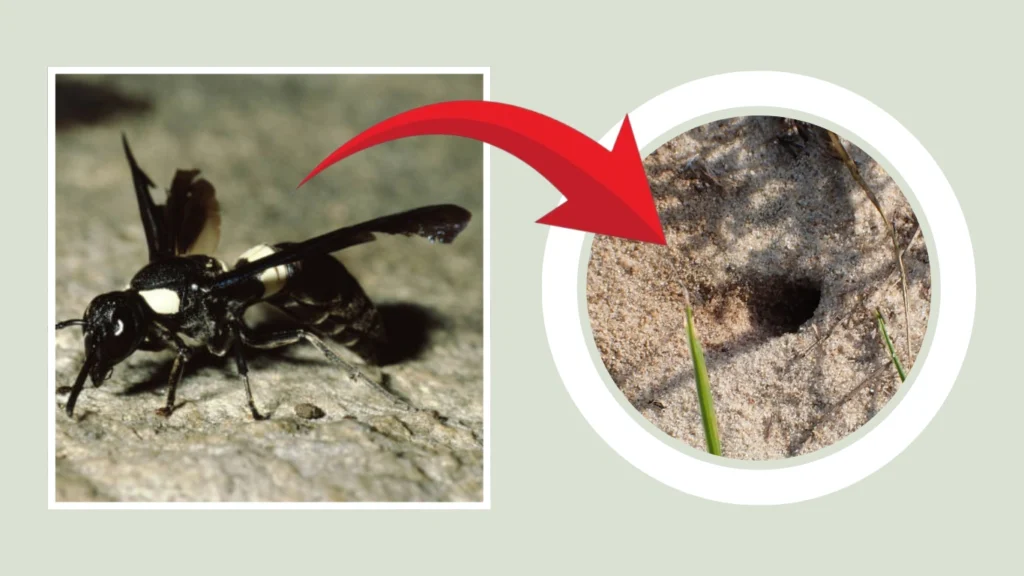
Horse guard wasps dig burrows in sandy soil. Each burrow may have several chambers where the female stores captured horse flies before laying eggs. These nests are often found in open fields or along paths where horse flies are abundant.
Habitat
They prefer open, sunny areas with dry, loose soil. Common locations include pastures, farmland, sandy trails, and meadows. Their habitat choice aligns closely with that of their prey—horse flies.
Behavior
These wasps are solitary and non-aggressive toward humans. Females are efficient predators of adult horse flies, grabbing them in flight and carrying them to their burrows. Their presence near horses is typically beneficial rather than threatening.
Reproduction & Lifecycle
After capturing several horse flies, the female lays a single egg in each chamber and seals it. The larva feeds on the stored prey, pupates, and emerges as an adult. This species typically has one generation per year, with activity peaking in midsummer.
18. Dolichovespula
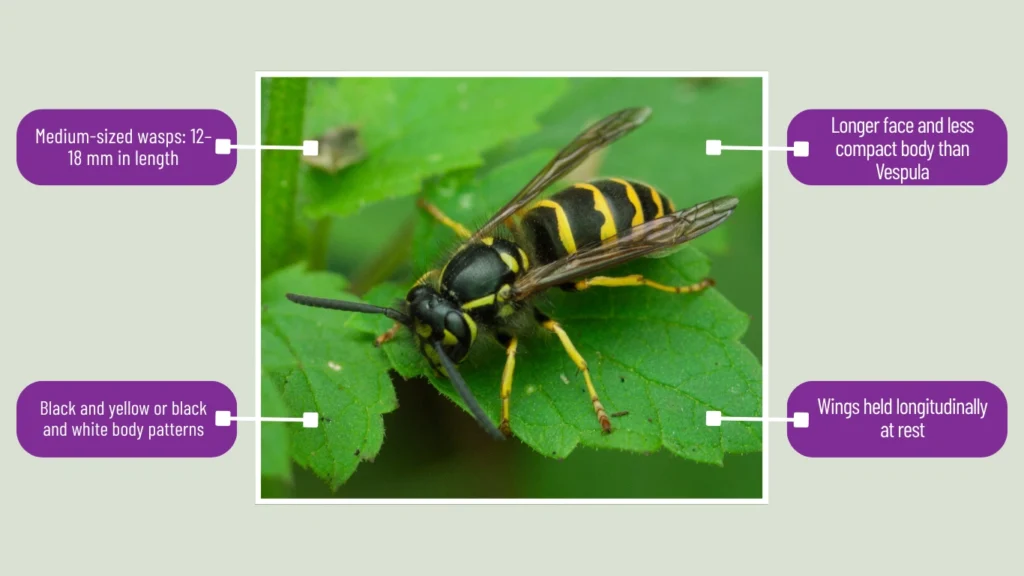
Dolichovespula is a genus of social wasps closely related to Vespula, but with more aerial nesting habits. These wasps are known for their aggressive defense behaviors and important role in controlling insect populations.
Identification
- Medium-sized wasps: 12–18 mm in length
- Black and yellow or black and white body patterns
- Longer face and less compact body than Vespula
- Wings held longitudinally at rest
- Clear distinction between thorax and abdomen
Nest
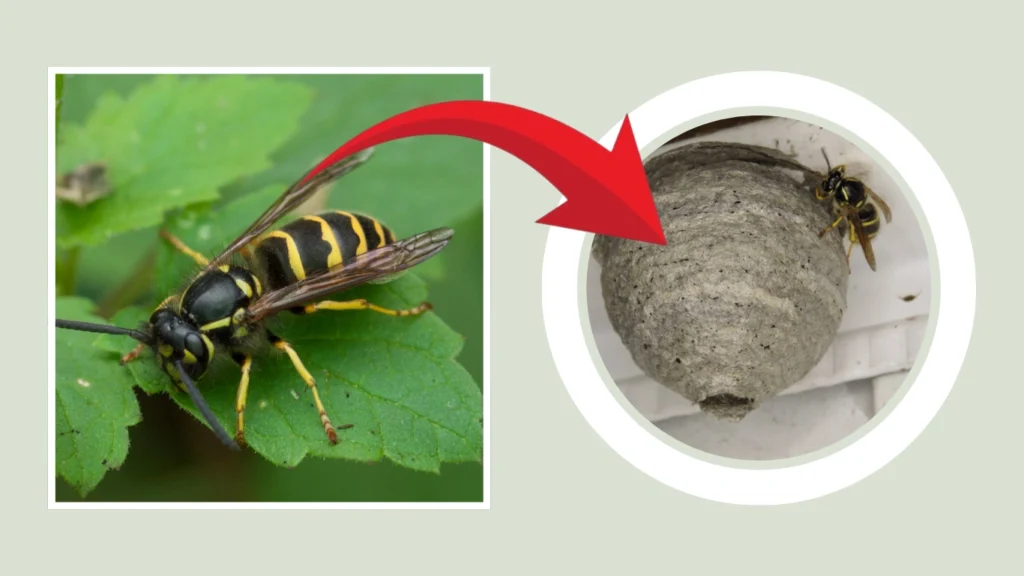
Dolichovespula species typically build aerial nests, often hanging from tree branches or under eaves. The nests are spherical or football-shaped and made from paper-like material. They are multilayered and house a large number of individuals by late summer.
Habitat
They inhabit temperate regions of North America, Europe, and Asia. Preferred locations include woodlands, parks, suburban gardens, and building exteriors. Nests are commonly placed in trees or under structural overhangs.
Behavior
These wasps are very defensive of their nests and will sting repeatedly if threatened. Workers hunt caterpillars and other insects to feed the colony’s larvae. Adults consume nectar, fruit juices, and sugary liquids.
Reproduction & Lifecycle
The lifecycle begins with a solitary queen emerging in spring to establish a new nest. She raises the first batch of workers, who then support the colony’s growth. New queens and males appear in late summer. The colony dies off in winter, except for the mated queens.
19. Euspinolia militaris

Euspinolia militaris, often nicknamed the panda ant due to its black and white coloration, is a solitary wasp species native to Chile. Despite its common name, it is a wasp belonging to the Mutillidae family.
Identification
- Small, fuzzy body with bold black and white “panda-like” pattern
- Wingless females and winged males
- Size ranges from 8–12 mm
- Short antennae and a dense covering of hair
- Females are strong and quick-moving
Nest

This species does not build its own nest. Instead, females infiltrate the nests of ground-nesting bees or wasps to lay their eggs. The larva then consumes the host larva and food supply, developing within the safety of the stolen nest.
Habitat
They are found in dry, sandy environments, especially scrublands and deserts in Chile. These wasps are terrestrial and most often observed walking on the ground in open sunlight.
Behavior
Panda ants are solitary and non-aggressive unless handled. The females have a powerful sting, used defensively. They are active during the day and are primarily focused on locating host nests for reproduction.
Reproduction & Lifecycle
After locating a suitable host nest, the female lays her egg inside. The larva develops by consuming the host’s larva and resources. It pupates inside the same nest and emerges as an adult. No social structure or colony is formed.
20. Ropalidia marginata
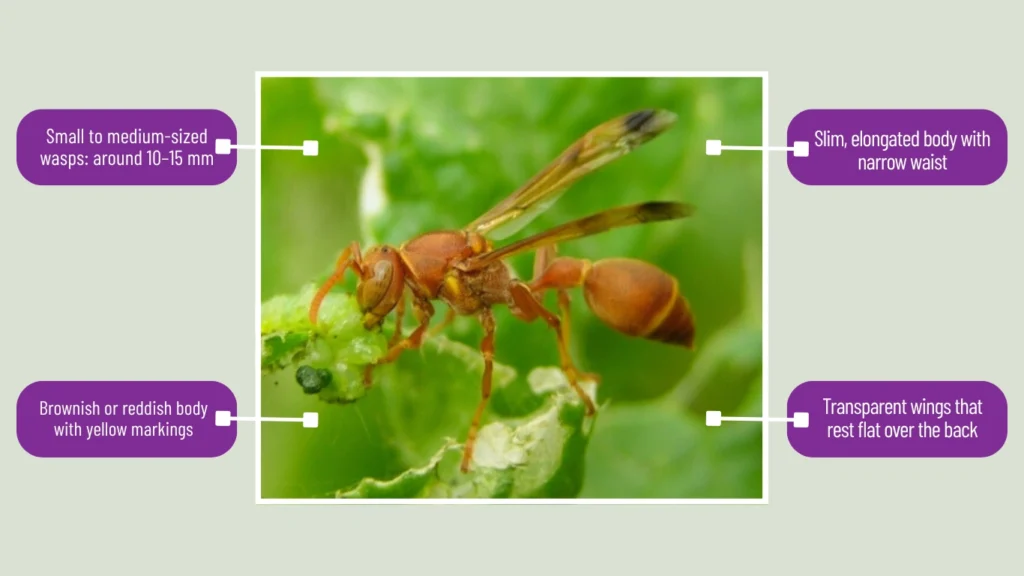
Ropalidia marginata is a species of paper wasp native to southern Asia. Known for its unique social structure and mild temperament, this wasp species has been extensively studied for its behavioral complexity.
Identification
- Small to medium-sized wasps: around 10–15 mm
- Brownish or reddish body with yellow markings
- Slim, elongated body with narrow waist
- Transparent wings that rest flat over the back
- Workers and queens look nearly identical
Nest
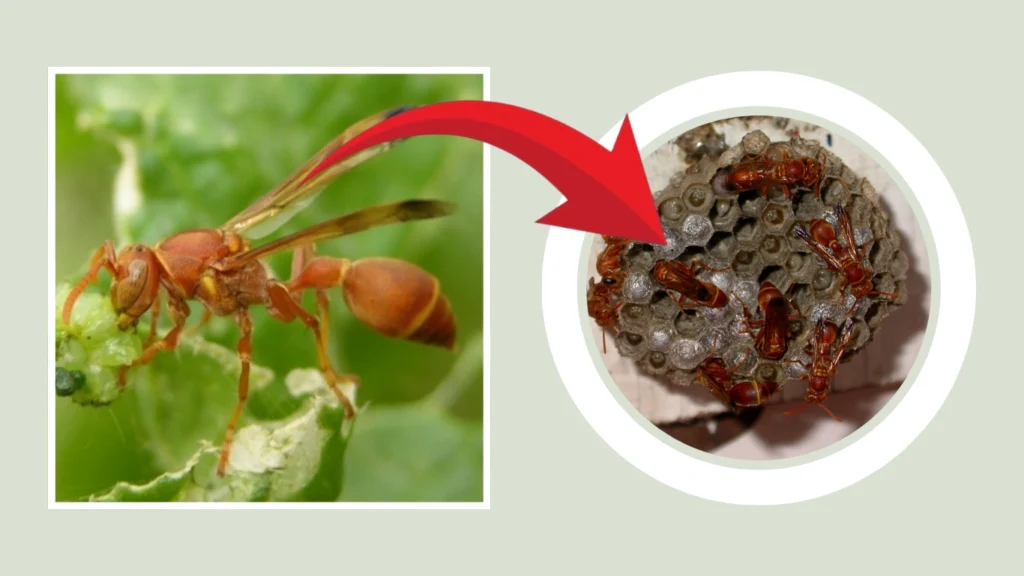
They build open, paper-like nests with exposed hexagonal cells. The nests are usually attached to tree branches, walls, or under roofs. Unlike most social wasps, multiple foundresses may start the nest together, and hierarchy is determined behaviorally.
Habitat
Ropalidia marginata prefers tropical and subtropical regions, especially in India and Southeast Asia. They are commonly found in gardens, under eaves, tree canopies, and on manmade structures.
Behavior
These wasps are relatively non-aggressive. Colonies are maintained by a queen whose dominance is signaled chemically rather than through aggression. Workers hunt caterpillars and insects to feed larvae and collect nectar for themselves.
Reproduction & Lifecycle
A dominant female becomes the queen and lays eggs, while others serve as workers. If the queen dies, one of the workers may become the next queen. Eggs develop into larvae, which pupate in their cells before emerging as adults. Colonies may persist for several months.
21. Synoeca
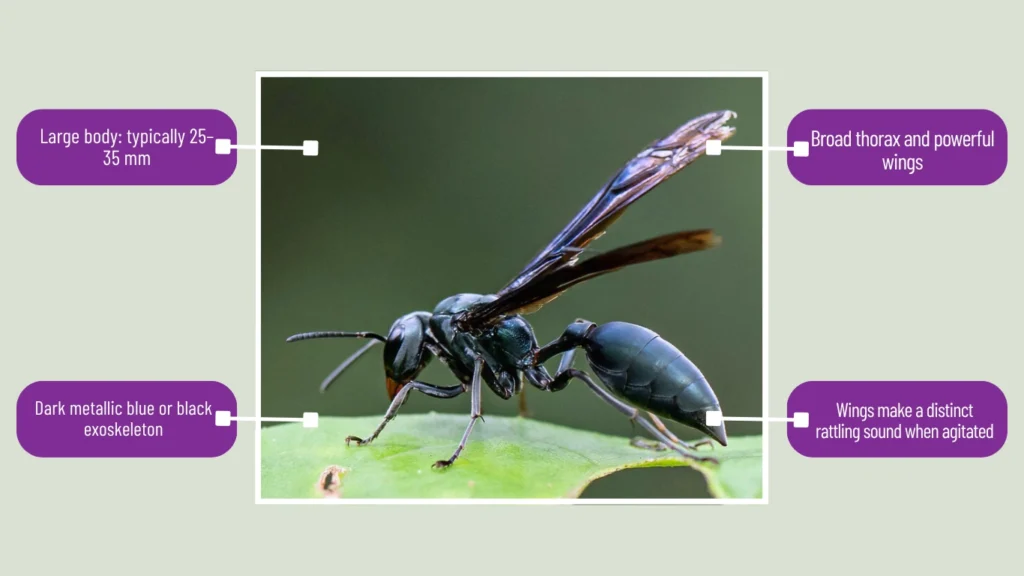
Synoeca, commonly known as warrior wasps, is a genus of large, social paper wasps found in Central and South America. They are famous for their intimidating wing-beating defense display and painful sting.
Identification
- Large body: typically 25–35 mm
- Dark metallic blue or black exoskeleton
- Broad thorax and powerful wings
- Wings make a distinct rattling sound when agitated
- Robust legs and visible mandibles
Nest
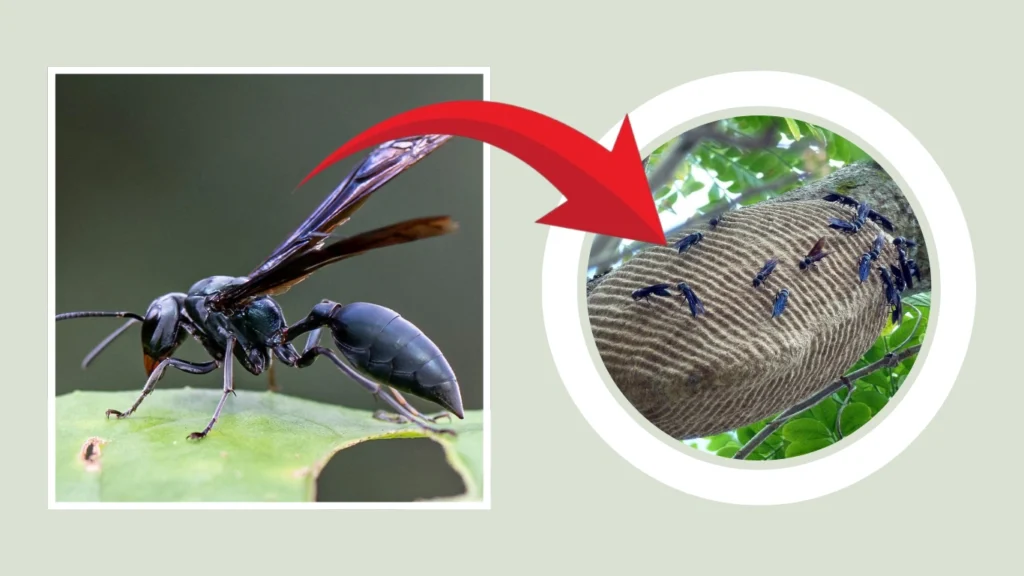
These wasps build large, shield-shaped paper nests attached to tree trunks or large branches. The nest surface appears smooth and brown, resembling tree bark. Colonies can grow to contain several hundred individuals.
Habitat
They are found in tropical rainforests and jungle regions across Central and South America. Nests are usually built in trees in humid, shaded environments.
Behavior
Synoeca wasps are highly defensive. When threatened, they beat their wings in unison to produce a loud buzzing as a warning. If the threat continues, they will attack with powerful, painful stings. Their sting is considered one of the most painful among wasps.
Reproduction & Lifecycle
A single queen lays eggs in hexagonal nest cells, cared for by a caste of workers. The colony includes workers, males, and future queens. New queens leave the nest to start new colonies. The lifecycle follows typical social wasp stages: egg, larva, pupa, and adult.
22. Mexican Honey Wasp
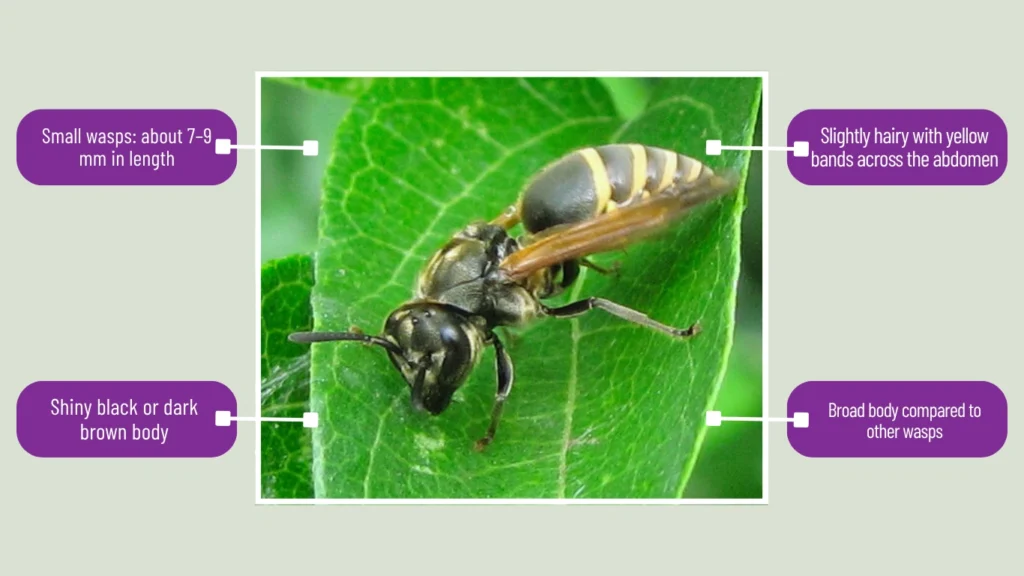
The Mexican honey wasp (Brachygastra mellifica) is one of the few wasp species known to produce and store honey. Native to Mexico and the southern United States, this social wasp plays an important role in pollination and pest control.
Identification
- Small wasps: about 7–9 mm in length
- Shiny black or dark brown body
- Slightly hairy with yellow bands across the abdomen
- Broad body compared to other wasps
- Less intimidating in appearance than hornets or yellowjackets
Nest
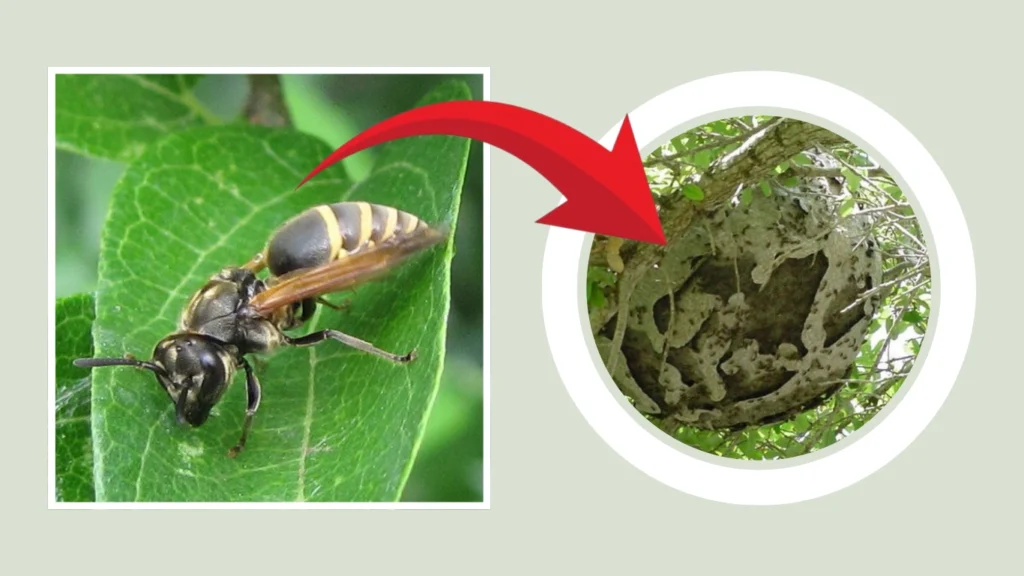
These wasps build large, enclosed paper nests often hidden in tree branches or shrubs. The nests are usually spherical and made of chewed plant material. Inside, they contain multiple combs used for brood and honey storage.
Habitat
Mexican honey wasps are commonly found in tropical and subtropical environments, especially in Mexico, Central America, and the southern U.S. They prefer wooded areas and farmlands with flowering plants.
Behavior
They are non-aggressive and rarely sting unless disturbed. Workers forage for nectar and insects. The nectar is converted into honey, stored within the nest for colony use. Their calm behavior and pollination habits make them beneficial insects.
Reproduction & Lifecycle
Colonies include a queen, male drones, and sterile female workers. The queen lays eggs in waxy combs. Larvae are fed on nectar and insect prey. The lifecycle includes complete metamorphosis: egg, larva, pupa, and adult. Colonies may persist across seasons in warm climates.
23. Polybia
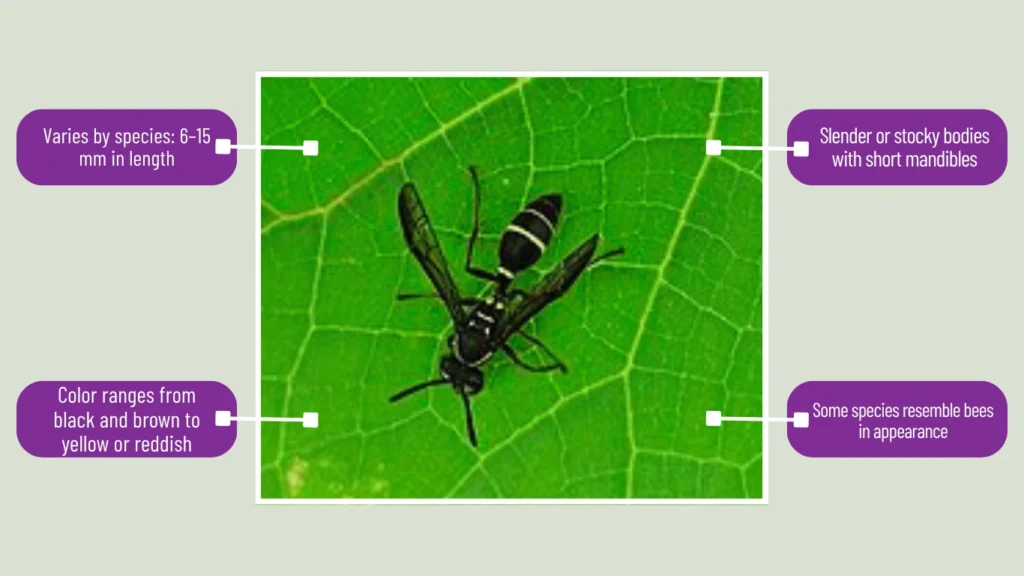
Polybia is a diverse genus of social wasps found throughout Central and South America. Some species in this genus are known for their complex nest architecture and defensive behaviors, while others are quite docile.
Identification
- Varies by species: 6–15 mm in length
- Color ranges from black and brown to yellow or reddish
- Slender or stocky bodies with short mandibles
- Some species resemble bees in appearance
- Clear or smoky wings depending on the species
Nest
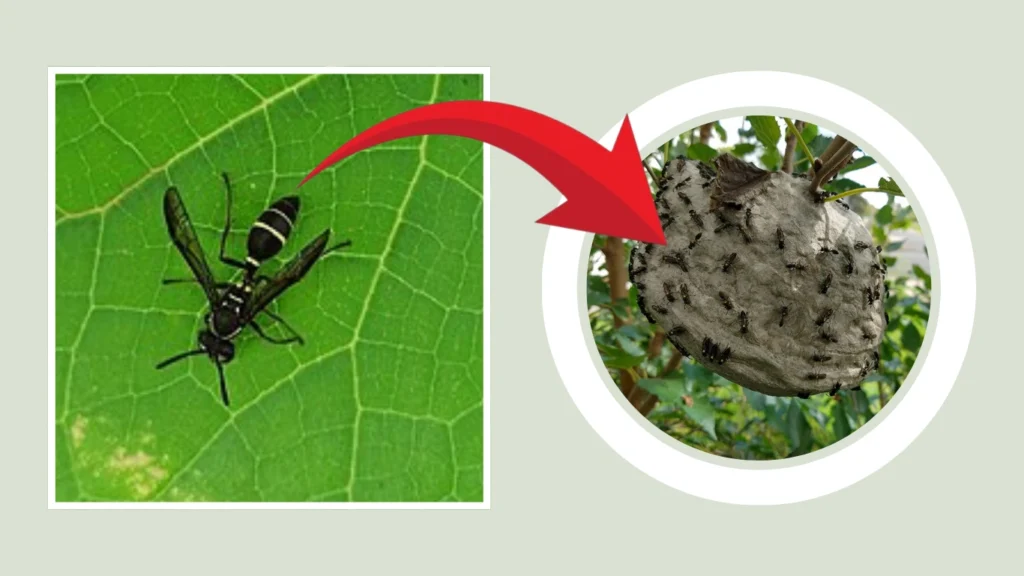
Polybia species build multi-layered paper nests that may be exposed or enclosed, depending on the species. Nests are often suspended from branches or built on vertical surfaces. Some species are known to construct elaborate defensive entrances.
Habitat
They inhabit tropical rainforests, savannas, and occasionally urban environments. Nests are typically located in trees, under large leaves, or in man-made structures. Their distribution spans Central and South America.
Behavior
Behavior varies widely across the genus. Some Polybia species are aggressive and deliver painful stings, while others are mild and avoid conflict. Many prey on caterpillars and other insects. They also collect nectar and sugary secretions.
Reproduction & Lifecycle
Colonies consist of a dominant queen and numerous sterile workers. Eggs are laid in comb cells and cared for by workers. The brood passes through larval and pupal stages before emerging as adults. Some species are known to swarm and form new colonies frequently.
24. Evania appendigaster

Evania appendigaster, commonly known as the blue-eyed ensign wasp, is a small parasitic wasp known for targeting cockroach egg cases (oothecae). Despite its intimidating name, this wasp is harmless to humans and considered beneficial for natural pest control.
Identification
- Small body: about 6–10 mm in length
- Black or dark blue body with metallic sheen
- Distinctive stalked abdomen attached high on the thorax
- Clear wings and bright blue eyes
- Slender legs and thread-like antennae
Nest
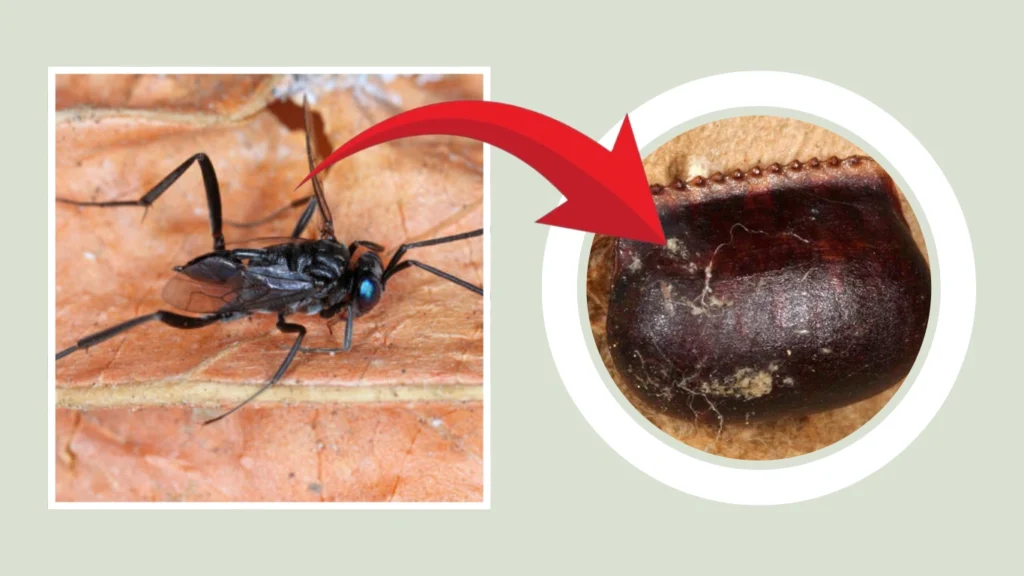
This wasp does not build its own nest. Instead, the female locates cockroach oothecae (egg cases) in hidden environments like basements, kitchens, or under appliances. She inserts her egg into the egg case, where her larva will consume the cockroach embryos.
Habitat
Commonly found in urban areas where cockroaches thrive—kitchens, basements, warehouses, and sewers. They are also seen in gardens, especially near compost or decaying material that attracts roaches.
Behavior
Non-aggressive and solitary, this wasp is often unnoticed due to its small size. Females actively search for cockroach egg cases to parasitize. They are beneficial for pest control and do not sting or pose any threat to humans or pets.
Reproduction & Lifecycle
After locating a suitable cockroach ootheca, the female inserts a single egg inside. The larva feeds on the developing cockroach nymphs, eventually pupating and emerging as an adult. Their lifecycle is entirely dependent on the availability of host egg cases.
25. Pompilus
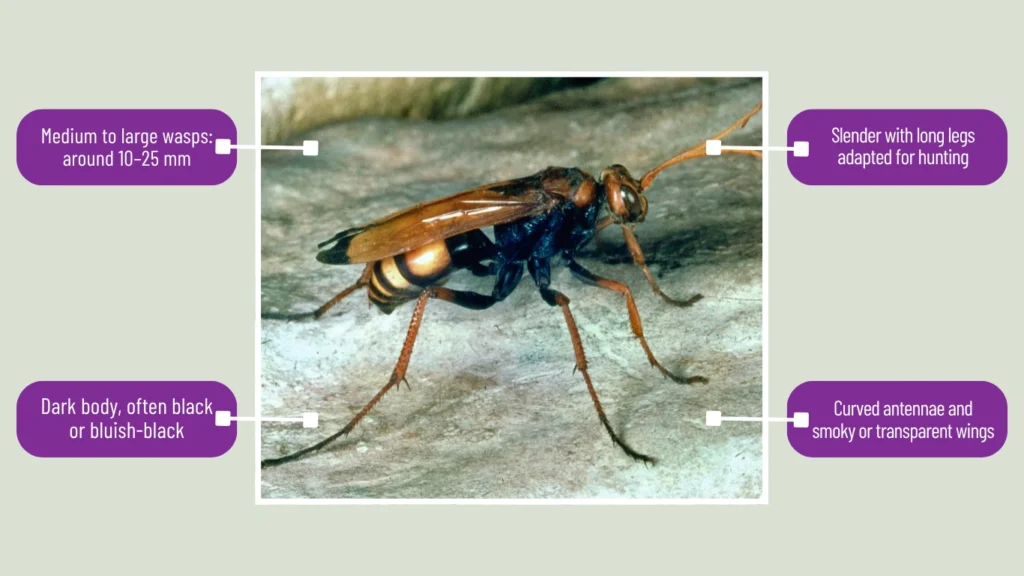
Pompilus is a genus within the spider wasp family, commonly referred to as spider wasps. These solitary hunters are known for paralyzing spiders and burying them in nests to serve as food for their offspring.
Identification
- Medium to large wasps: around 10–25 mm
- Dark body, often black or bluish-black
- Slender with long legs adapted for hunting
- Curved antennae and smoky or transparent wings
- Quick, darting flight pattern close to the ground
Nest
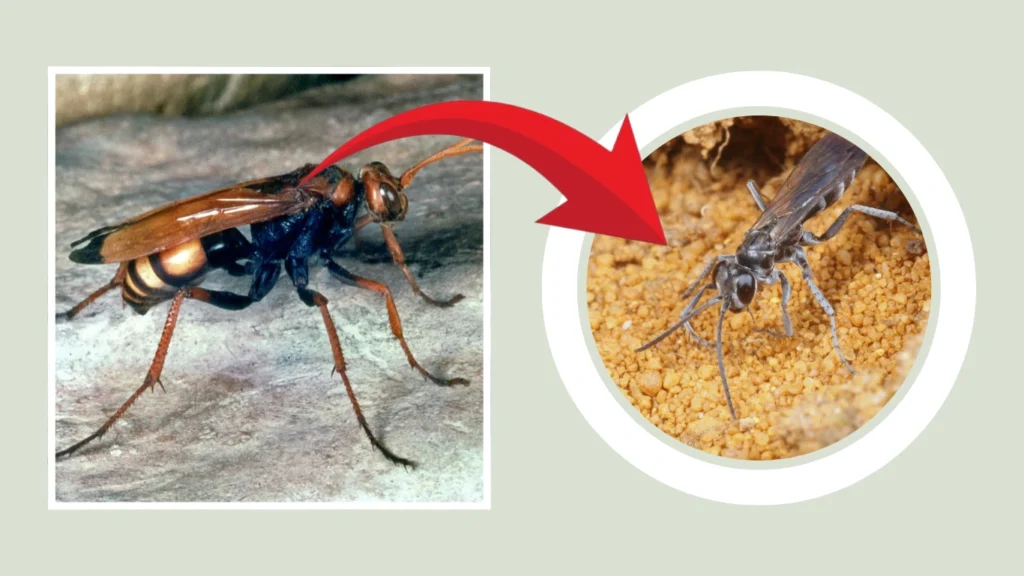
Pompilus wasps dig burrows in sandy or loose soil. Inside the nest, they place a single paralyzed spider and lay one egg on it. The burrow is then sealed to protect the developing larva. Nests may be simple or multi-chambered depending on species.
Habitat
They favor dry, sandy environments such as fields, dunes, forest clearings, and even urban gardens. These wasps are typically observed hunting on the ground, searching for spider prey.
Behavior
These wasps are solitary and rarely sting unless provoked. Females paralyze spiders with a sting and drag them—sometimes across long distances—to the nest. Adults feed on nectar, while their larvae develop by consuming the captured spider.
Reproduction & Lifecycle
Once the spider is paralyzed and buried, the female lays an egg on it. The larva feeds externally on the spider’s tissues, avoiding vital organs to keep it fresh. Pupation occurs inside the burrow, and the adult emerges the following season.
26. Bembix rostrata
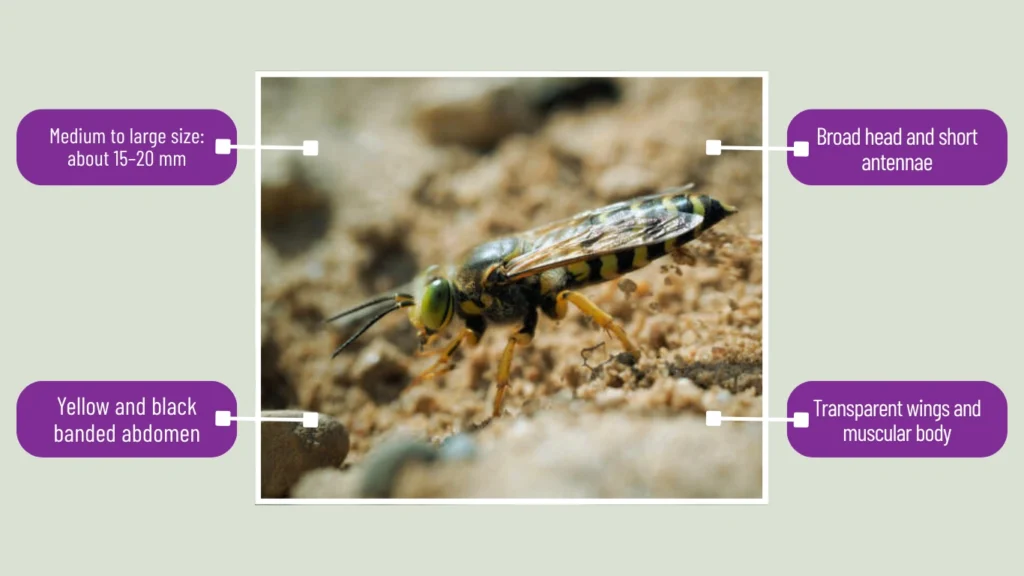
Bembix rostrata is a solitary sand wasp known for its ground-nesting behavior and swift hunting style. These wasps are often seen in sandy habitats and are recognizable by their striking black and yellow markings.
Identification
- Medium to large size: about 15–20 mm
- Yellow and black banded abdomen
- Broad head and short antennae
- Transparent wings and muscular body
- Distinctive hovering flight near the ground
Nest
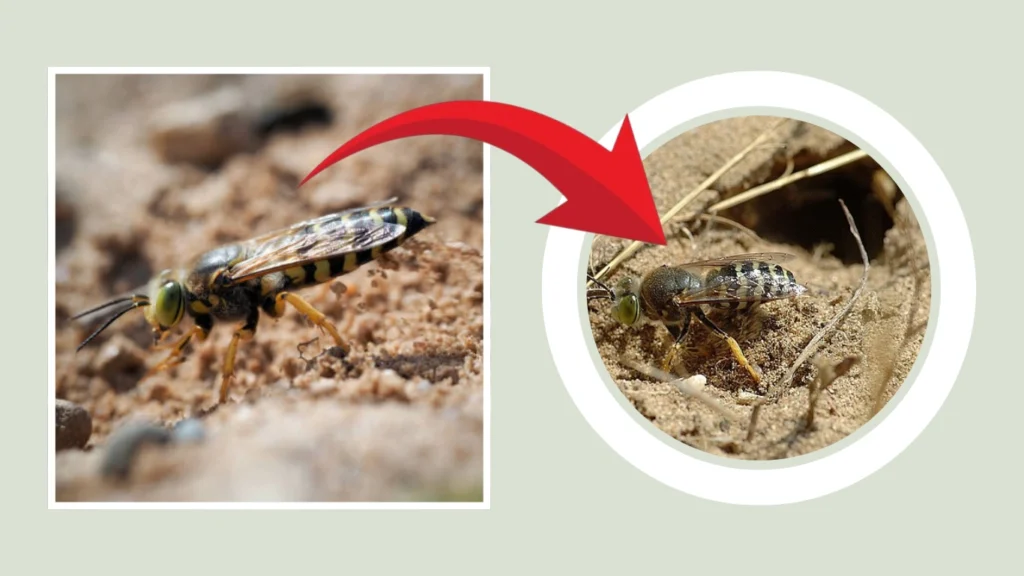
Females dig burrows in sandy soil, often in colonies but each with its own individual nest. The nest includes a tunnel and side chambers where the female places paralyzed flies or other insects alongside her eggs.
Habitat
These wasps prefer open, sandy areas such as dunes, dry riverbeds, heaths, and coastal regions. They are often found in sun-exposed areas with loose, dry soil ideal for burrowing.
Behavior
Bembix wasps are solitary but tolerant of nesting close to others. Females are skilled hunters, capturing flies and other insects mid-air. They are non-aggressive and rarely sting humans. Adults feed on nectar and are active during warm summer months.
Reproduction & Lifecycle
After provisioning a burrow with prey, the female lays a single egg and seals the chamber. The larva feeds on the stored insect, then pupates within the nest. The adult emerges later in the season or the following year, depending on the climate.
27. Beewolf
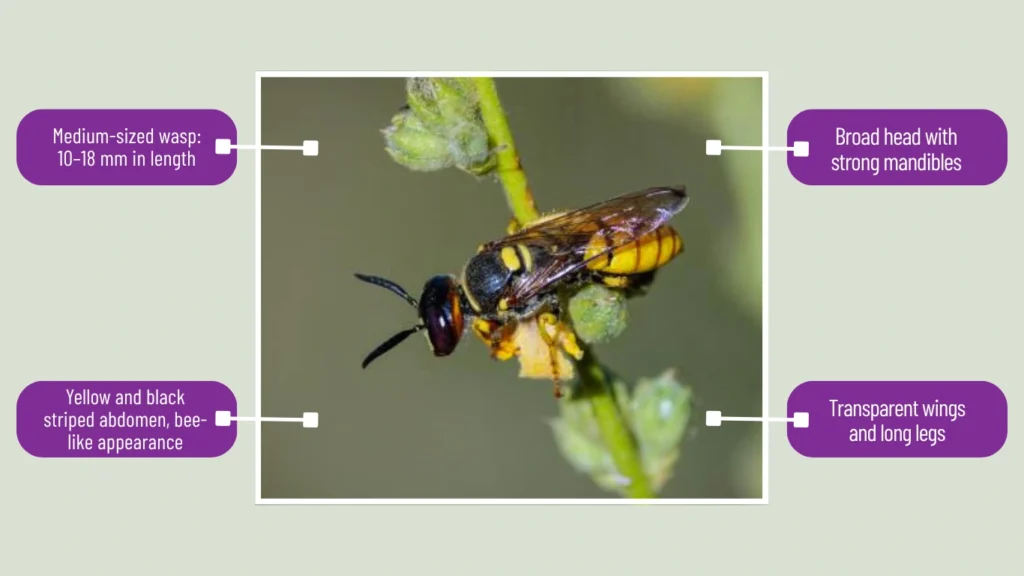
The beewolf (Philanthus triangulum) is a solitary wasp famous for hunting honey bees. Despite its name and behavior, it plays an important ecological role and is not a threat to entire bee populations.
Identification
- Medium-sized wasp: 10–18 mm in length
- Yellow and black striped abdomen, bee-like appearance
- Broad head with strong mandibles
- Transparent wings and long legs
- Easily mistaken for a small hornet
Nest
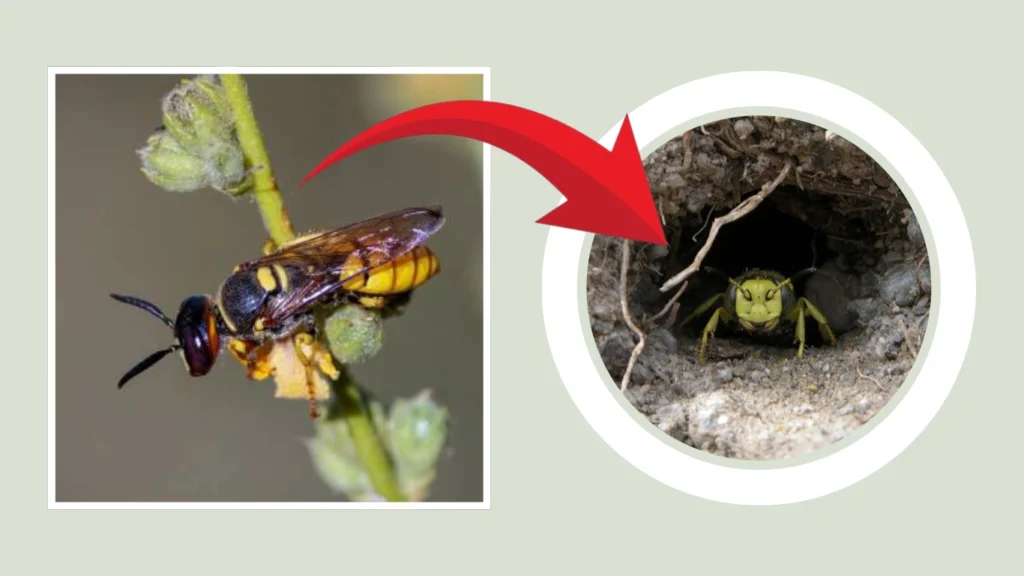
Beewolves dig tunnels in dry, sandy soil. Each tunnel contains several brood cells, each stocked with a captured honey bee. The female lays an egg on the bee and seals the chamber. Nests are usually built in sunny, open areas.
Habitat
They prefer sandy, well-drained soils in open landscapes such as heaths, gardens, dunes, and grasslands. Beewolves often form loose nesting aggregations where conditions are favorable.
Behavior
Beewolves are solitary and rarely aggressive toward humans. Females paralyze honey bees and carry them back to their burrows. Adults feed on nectar and are most active in midsummer when bee activity is high.
Reproduction & Lifecycle
The female places one paralyzed bee in each cell along with her egg. The larva feeds on the bee, pupates, and may overwinter in the soil. Adults emerge in summer and repeat the cycle, with one generation per year in most regions.
28. Blue Ant
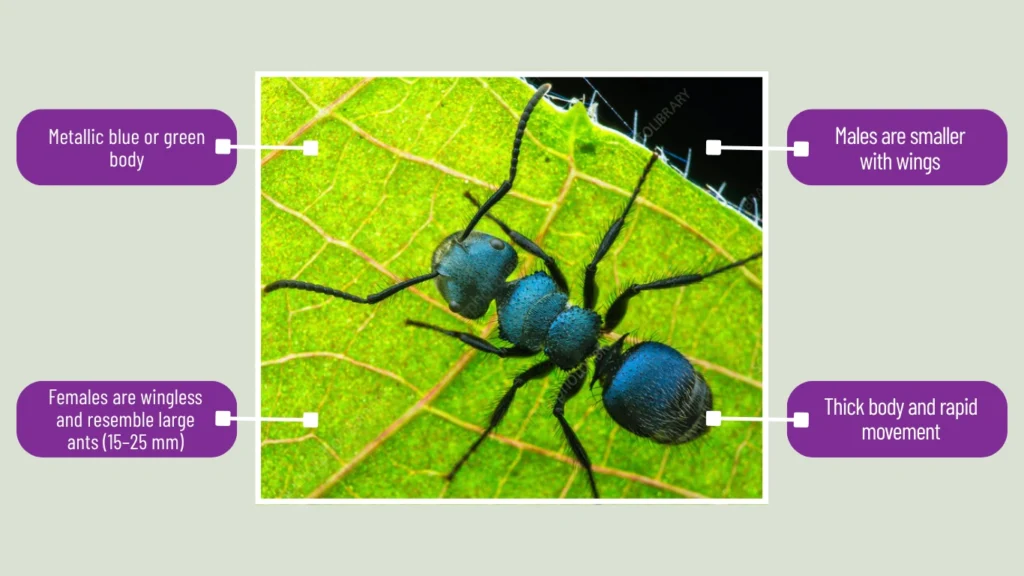
Despite its name, the blue ant (Diamma bicolor) is a species of solitary wasp native to Australia. The females are flightless and resemble large ants, while males have wings. This striking insect is known for its metallic blue coloration and parasitic behavior.
Identification
- Metallic blue or green body
- Females are wingless and resemble large ants (15–25 mm)
- Males are smaller with wings
- Red legs provide strong contrast against the blue body
- Thick body and rapid movement
Nest
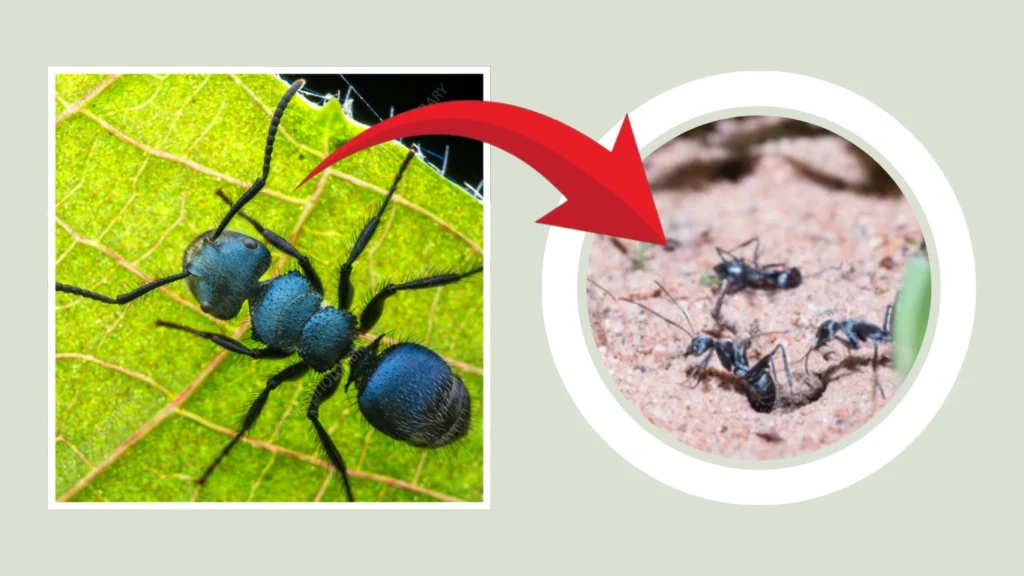
Blue ants do not build traditional nests. The female searches for mole cricket burrows, paralyzes the host, and lays an egg on it underground. The larva feeds on the host as it develops.
Habitat
Found in southeastern Australia, especially in heathlands, woodlands, and gardens. Females are often seen walking on the ground in search of prey. They prefer moist, sandy soils where mole crickets are active.
Behavior
Females are solitary and hunt mole crickets by scent and vibration. They are not aggressive toward humans but can deliver a painful sting if handled. Males are short-lived and fly in search of mates. Adults feed on nectar and help pollinate native plants.
Reproduction & Lifecycle
After paralyzing a mole cricket, the female lays an egg on it and buries it underground. The larva feeds on the still-living host, then pupates in the soil. Adults emerge in summer, and only one generation occurs per year.
29. Chrysis ignita
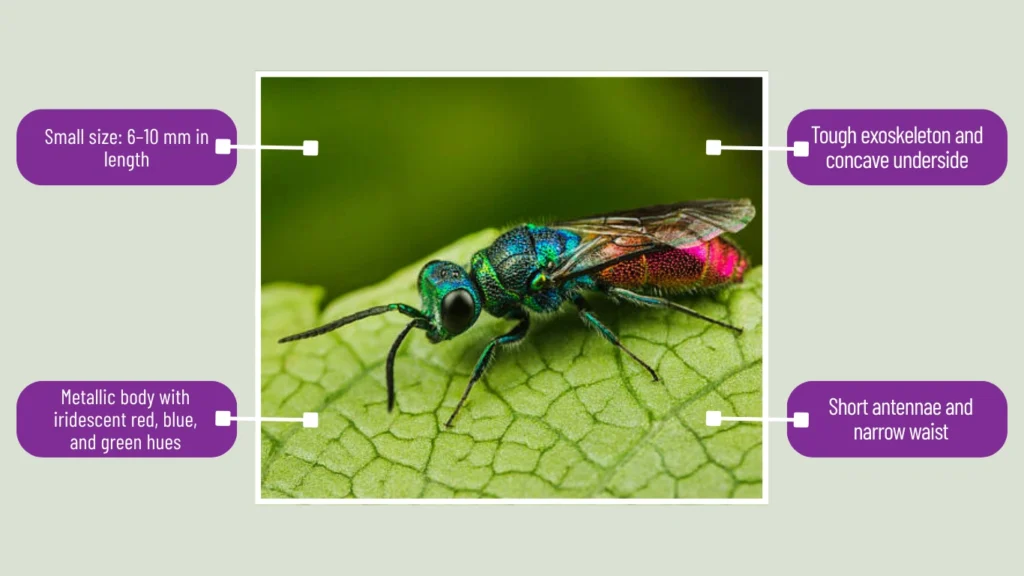
Chrysis ignita, commonly known as the ruby-tailed wasp, is a small, brilliantly colored parasitic wasp found across Europe and parts of Asia. It is known for its metallic red, blue, and green body and for laying eggs in the nests of other solitary wasps and bees.
Identification
- Small size: 6–10 mm in length
- Metallic body with iridescent red, blue, and green hues
- Tough exoskeleton and concave underside
- Short antennae and narrow waist
- Females curl up tightly when threatened
Nest

This species does not construct its own nest. Instead, the female invades the nests of solitary bees or wasps, such as mason bees or potter wasps. She lays an egg inside the host’s nest, where her larva consumes the host egg or larva and stored food.
Habitat
Commonly found in sunny gardens, meadows, walls, dead wood, and sandy banks where host species build their nests. They are most active in warm weather and frequently observed visiting flowers or exploring potential host nests.
Behavior
Chrysis ignita is solitary and harmless to humans. The female stealthily searches for unguarded nests to parasitize. Adults feed on nectar and are important pollinators despite their parasitic reproduction.
Reproduction & Lifecycle
The female lays her egg inside a host nest. Upon hatching, the larva destroys the host’s offspring and consumes the stored pollen or prey. The larva then pupates inside the same chamber. Adults emerge during summer, completing one generation per year.
30. Ampulicidae
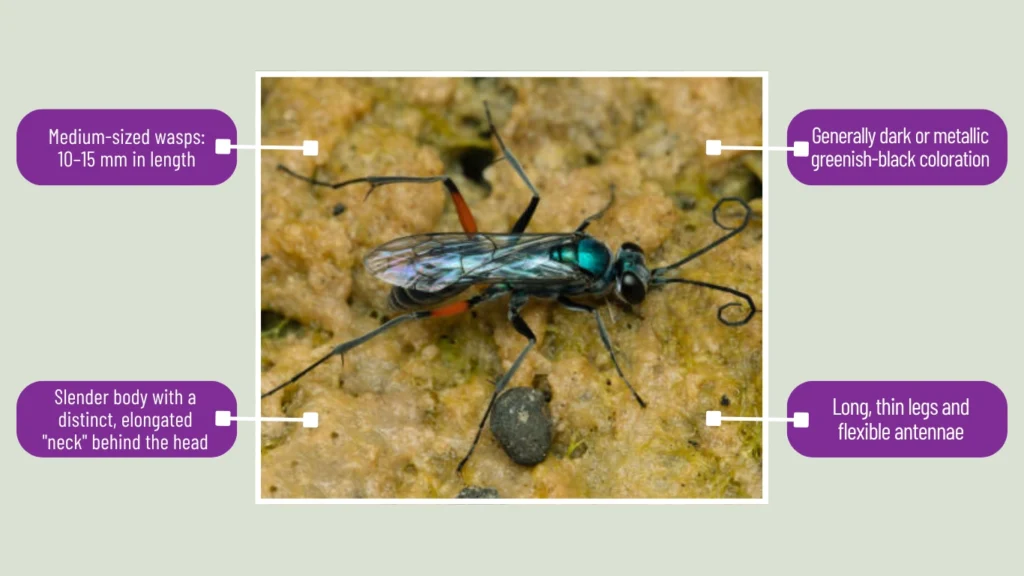
The Ampulicidae family, also known as cockroach wasps, includes solitary parasitic wasps that specialize in hunting cockroaches. These wasps use sophisticated methods to manipulate and paralyze their prey before nesting.
Identification
- Medium-sized wasps: 10–15 mm in length
- Slender body with a distinct, elongated “neck” behind the head
- Generally dark or metallic greenish-black coloration
- Long, thin legs and flexible antennae
- Often confused with spider wasps due to body shape
Nest
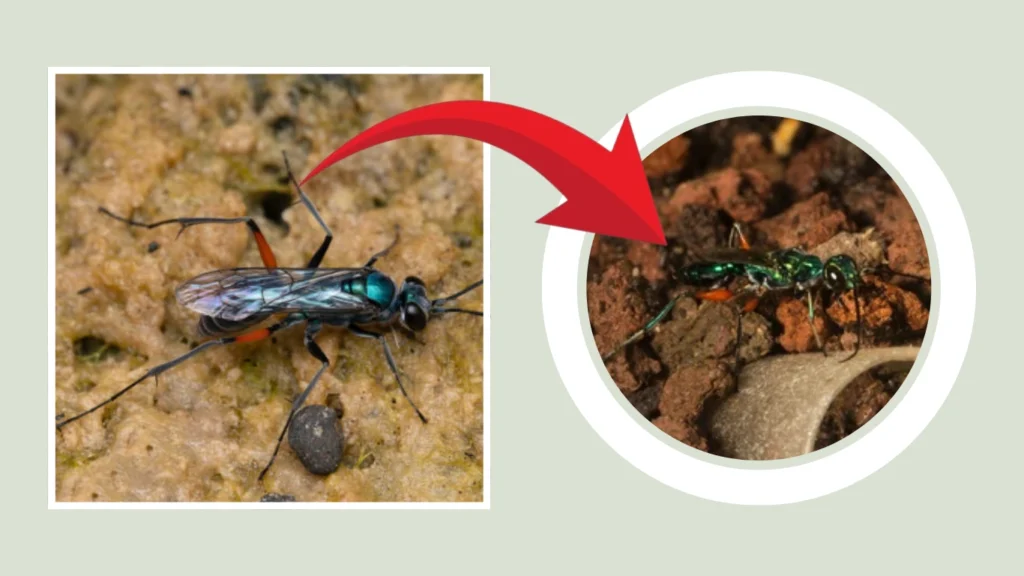
Ampulicid wasps do not build complex nests. Instead, they typically use crevices, cracks, or abandoned cavities to stash paralyzed cockroaches. Each prey item serves as a food source for a single larva. The nest is sealed with debris or soil after egg laying.
Habitat
They prefer warm, humid regions and are found in forests, gardens, and human dwellings where cockroaches are common. They are particularly active in shaded or concealed environments.
Behavior
These wasps display highly specialized hunting behavior. The female delivers a precise sting to the cockroach’s nerve center, temporarily paralyzing it. She then guides the still-living cockroach into a hiding place before laying an egg on it. Adults feed on nectar and are generally non-aggressive.
Reproduction & Lifecycle
After paralyzing a cockroach, the female lays an egg on it. The larva consumes the cockroach over several days. Pupation occurs within the same cavity, and an adult emerges to repeat the process. Only one egg is laid per prey item, ensuring exclusive resources.
31. Ampulex dementor
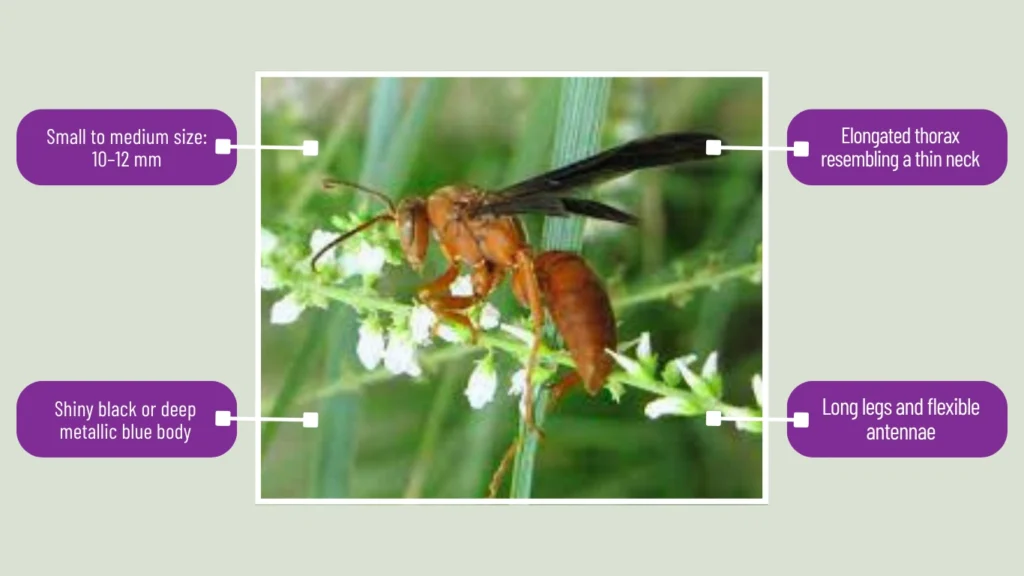
Ampulex dementor is a species of cockroach wasp named after the “Dementors” in Harry Potter, due to its eerie ability to zombify cockroaches. It belongs to the Ampulicidae family and is native to Southeast Asia.
Identification
- Small to medium size: 10–12 mm
- Shiny black or deep metallic blue body
- Elongated thorax resembling a thin neck
- Long legs and flexible antennae
- Smooth, glossy exoskeleton
Nest
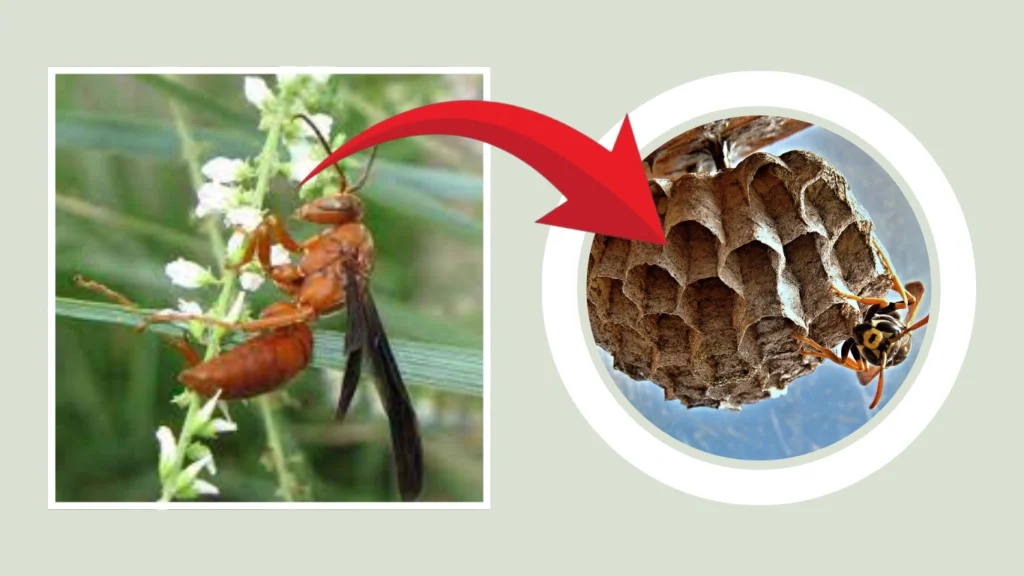
Similar to other cockroach wasps, Ampulex dementor uses existing crevices or hidden cavities for nesting. After paralyzing and leading a cockroach into a cavity, the female lays an egg on it and seals the chamber to protect the developing larva.
Habitat
Found in tropical forests of Southeast Asia, especially in regions like Thailand. These wasps dwell near cockroach habitats such as leaf litter, logs, and shaded crevices. They prefer humid environments where prey is abundant.
Behavior
This species is known for its precise and chilling hunting method: after stinging a cockroach in the brain, it turns the insect into a passive host. The wasp leads the “zombified” cockroach by its antenna into a nest site. Adults are harmless and feed on nectar.
Reproduction & Lifecycle
Once the host cockroach is positioned, the female lays a single egg on it. The larva hatches and slowly consumes the immobilized cockroach. Pupation follows, and the adult eventually emerges from the same chamber to begin the cycle anew.
32. Brachygastra lecheguana
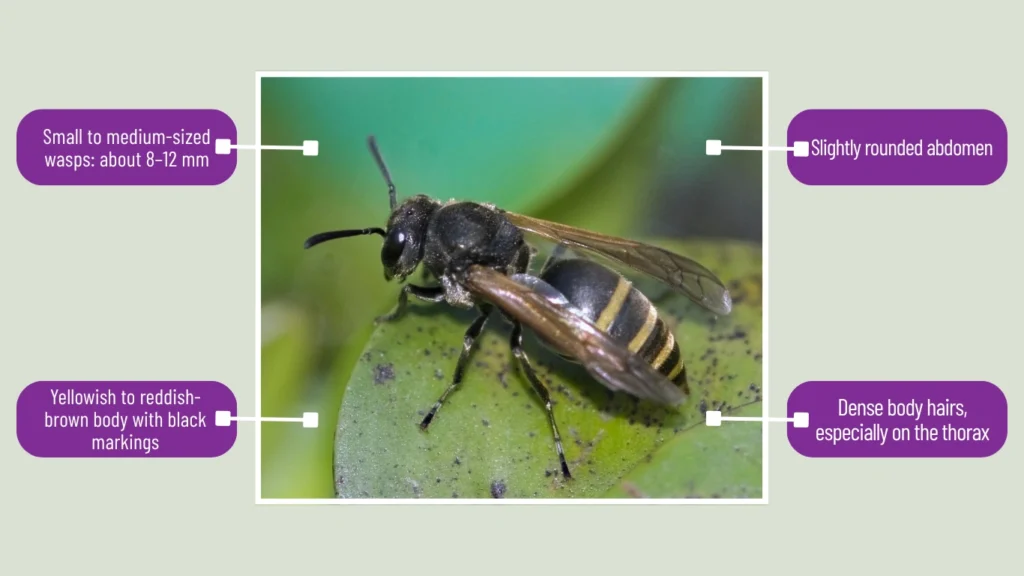
Brachygastra lecheguana is a species of social wasp native to Central and South America. It belongs to a genus of wasps known for producing honey and forming large colonies. These wasps contribute to pollination and natural pest control.
Identification
- Small to medium-sized wasps: about 8–12 mm
- Yellowish to reddish-brown body with black markings
- Slightly rounded abdomen
- Dense body hairs, especially on the thorax
- Less aggressive appearance compared to hornets
Nest
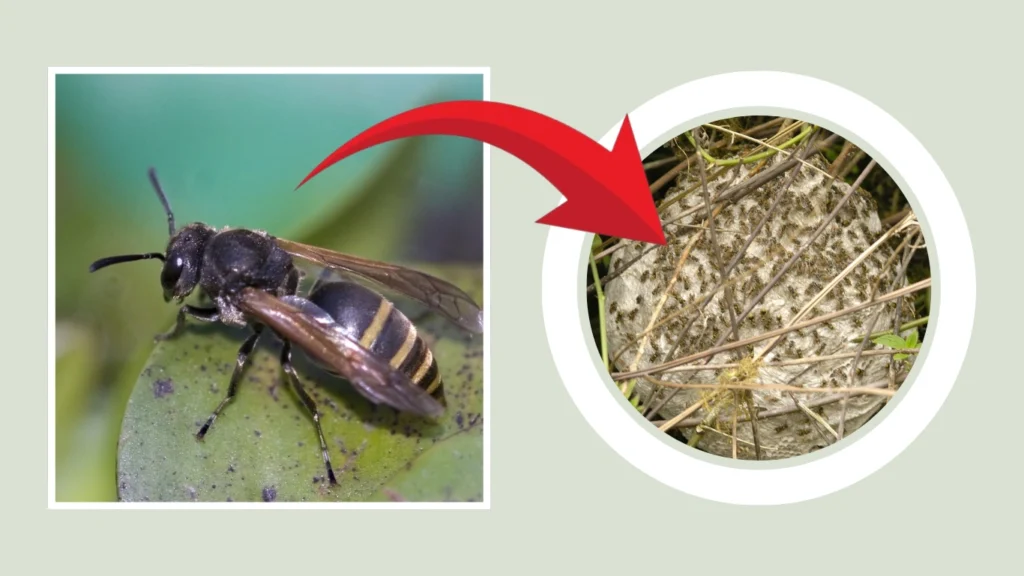
These wasps build paper nests hidden in dense vegetation or tree cavities. The nests are multi-combed and enclosed, with small openings. They often construct their nests in protected areas, sometimes in association with human structures.
Habitat
Brachygastra lecheguana thrives in tropical and subtropical forests, woodlands, and agricultural areas. They are frequently found in gardens, orchards, and near flowering trees. These wasps are attracted to both nectar and honeydew from aphids.
Behavior
They are social but not highly aggressive unless provoked. Workers forage for nectar, small insects, and sugary excretions from pests. They help control caterpillar and aphid populations. Some species in this genus also produce small amounts of honey within the nest.
Reproduction & Lifecycle
A queen starts the colony and lays eggs, while sterile female workers care for the brood and maintain the nest. Males and new queens are produced later in the season. After mating, only the fertilized queens overwinter to establish new colonies.
33. Diplolepis rosae
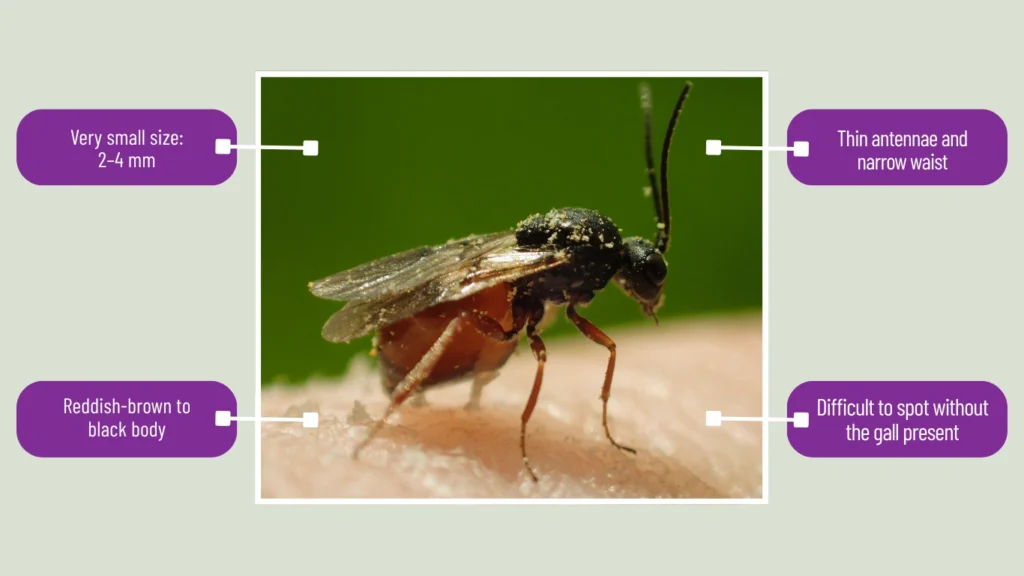
Diplolepis rosae, also known as the bedeguar gall wasp or robin’s pincushion wasp, is a tiny parasitic wasp famous for the mossy, reddish galls it creates on wild rose plants.
Identification
- Very small size: 2–4 mm
- Reddish-brown to black body
- Thin antennae and narrow waist
- Difficult to spot without the gall present
- Known primarily by the galls rather than the adult insect
Nest
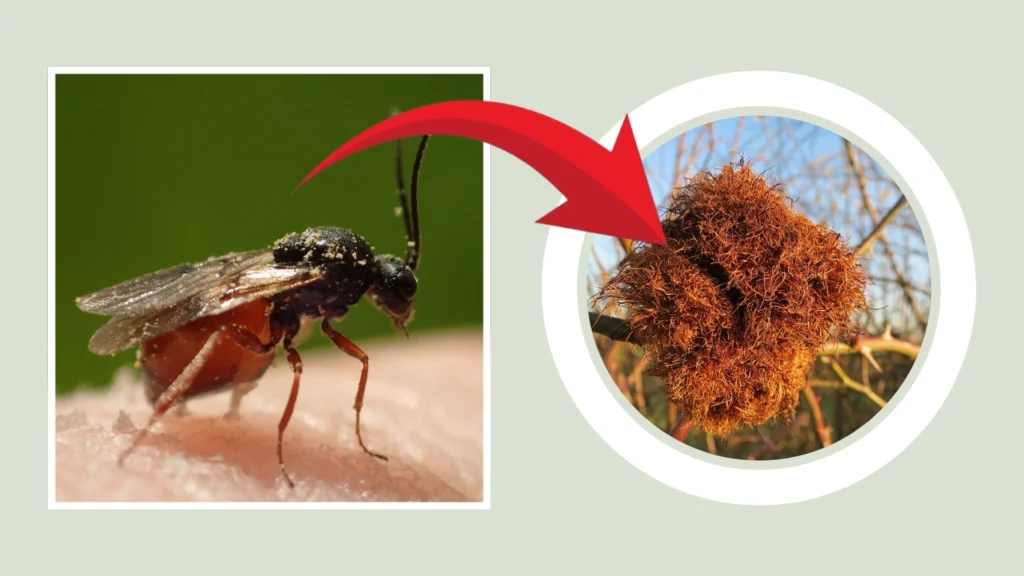
This wasp does not construct a nest in the traditional sense. Instead, the female lays eggs in the buds of wild rose plants. The resulting larval activity causes the plant to grow a large, hairy red gall—called a bedeguar gall—which serves as both shelter and food source.
Habitat
Common in temperate Europe and parts of western Asia. Found wherever wild roses grow, including meadows, forest edges, hedgerows, and gardens. The galls are most visible from late summer through fall.
Behavior
Diplolepis rosae is solitary and non-aggressive. The female selects young rose buds for oviposition. The larval presence manipulates plant hormones, forming the characteristic gall. Multiple larvae may develop within a single gall.
Reproduction & Lifecycle
The female lays numerous eggs inside a rose bud. Larvae hatch and induce the formation of a gall. They remain inside the gall throughout development, pupating within its chambers. Adults emerge in the following spring to repeat the cycle.
34. Dolichovespula sylvestris
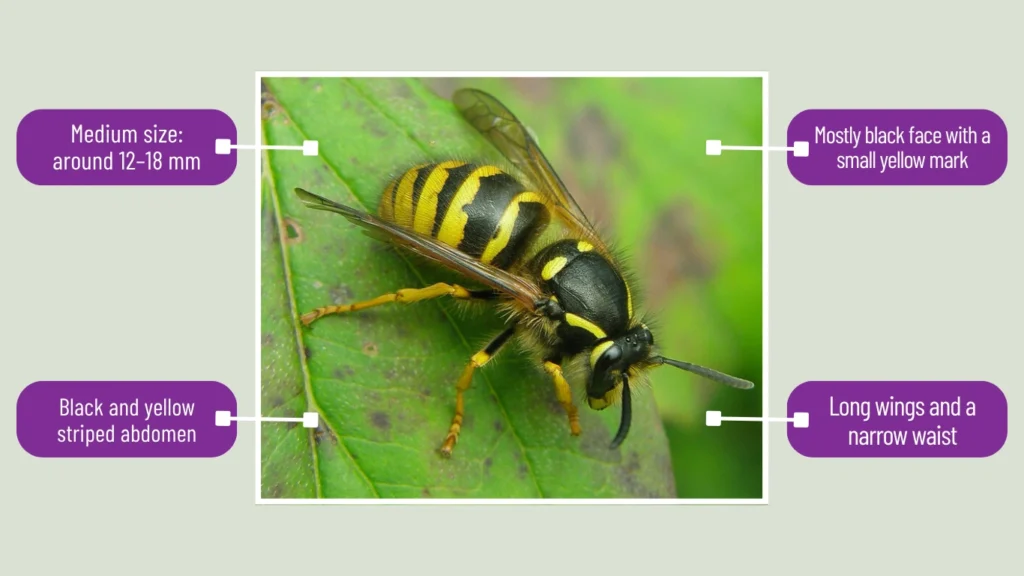
Dolichovespula sylvestris, also known as the tree wasp, is a social wasp species native to Europe. It is a common woodland species recognized for its aerial nests and wasp-like buzzing activity in mid-summer.
Identification
- Medium size: around 12–18 mm
- Black and yellow striped abdomen
- Mostly black face with a small yellow mark
- Long wings and a narrow waist
- Very similar to other Dolichovespula species but with specific facial patterns
Nest

This species typically builds paper nests high in trees, shrubs, or sometimes in roof eaves. The nests are spherical and constructed from chewed wood fibers, often hidden by foliage. They contain layers of brood cells and are used only for one season.
Habitat
Dolichovespula sylvestris prefers woodlands, forest edges, parks, and gardens. It is also found in suburban areas with access to trees or tall shrubs. The species favors elevated, shaded, and sheltered spots for nesting.
Behavior
Tree wasps are moderately aggressive, especially near the nest. Workers forage for insects like flies and caterpillars, which are fed to the larvae. Adults feed on nectar and sugary substances and may become a nuisance near outdoor food sources in late summer.
Reproduction & Lifecycle
The queen begins the nest in spring, lays eggs, and raises the first generation of workers. These workers take over nest duties while the queen focuses on egg-laying. In late summer, males and new queens are produced. The colony dies out in autumn, with only new queens overwintering.
35. Pepsis heros
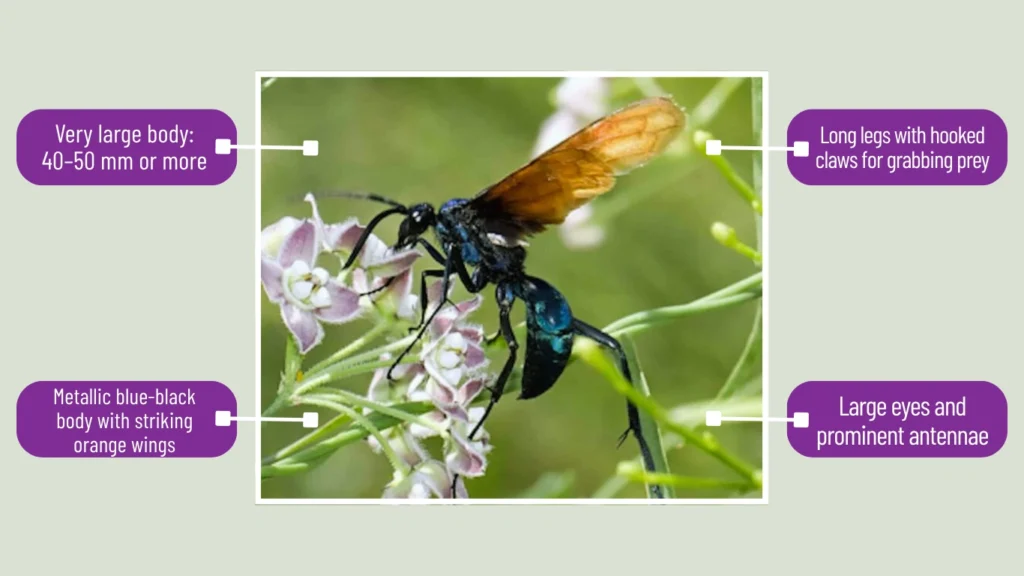
Pepsis heros is one of the largest species of tarantula hawk wasps, known for its powerful sting and incredible strength. It is found in South America and is a predator of large tarantulas, earning its reputation as a fierce solitary hunter.
Identification
- Very large body: 40–50 mm or more
- Metallic blue-black body with striking orange wings
- Long legs with hooked claws for grabbing prey
- Large eyes and prominent antennae
- Loud, buzzing flight and intimidating presence
Nest
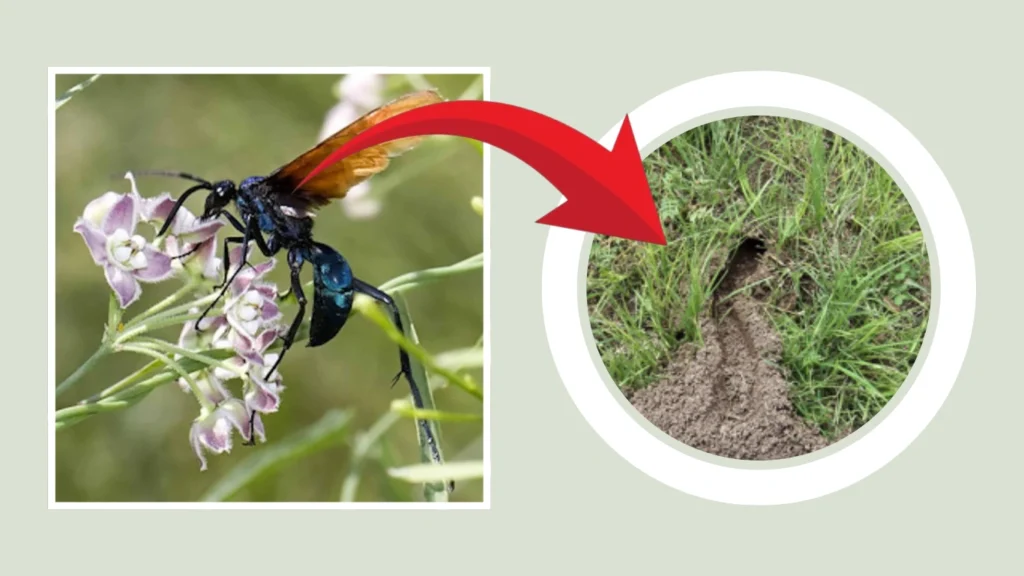
Pepsis heros does not build conventional nests. Instead, the female digs a burrow or uses an existing cavity, where she places a paralyzed tarantula and lays a single egg on it. The burrow is sealed to protect the larva during development.
Habitat
This species prefers warm, arid, or tropical environments, including deserts, forests, and grasslands. It is most often found in South America, especially in areas with abundant tarantula populations.
Behavior
Pepsis heros is solitary and typically non-aggressive unless provoked. Females are known for their powerful sting—rated among the most painful in the insect world. They hunt tarantulas by stinging and paralyzing them, then dragging them to their nest site. Adults feed on nectar and are strong flyers.
Reproduction & Lifecycle
After subduing a tarantula, the female lays an egg on its abdomen. The larva hatches and consumes the still-living spider, pupates within the burrow, and later emerges as an adult. The species typically produces one generation per year.
36. Dolichovespula saxonica
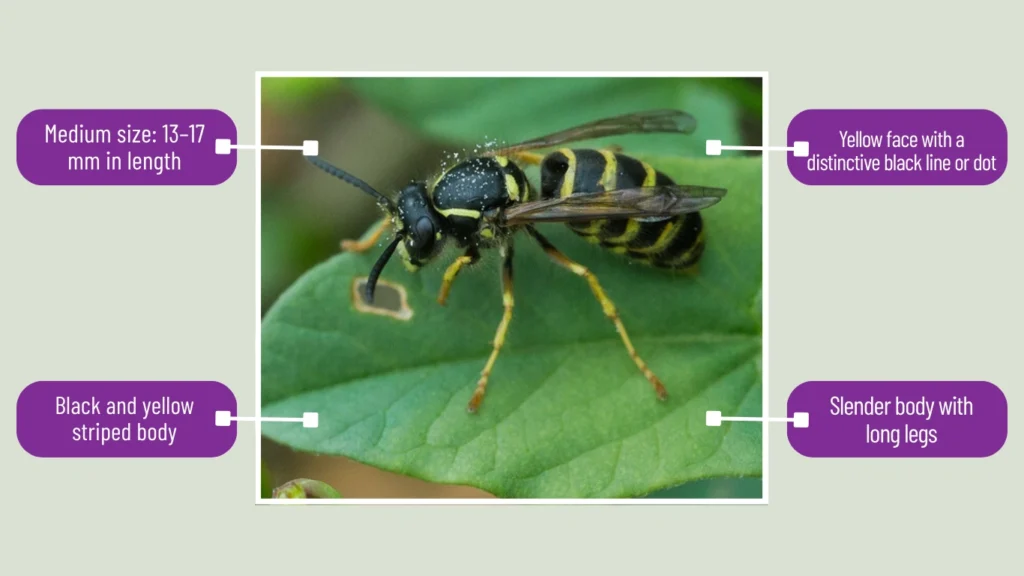
Dolichovespula saxonica, also known as the Saxon wasp, is a social species native to Europe and parts of Asia. It has become more common in urban areas in recent years and is known for building aerial nests in open environments.
Identification
- Medium size: 13–17 mm in length
- Black and yellow striped body
- Yellow face with a distinctive black line or dot
- Slender body with long legs
- Wings fold lengthwise when at rest
Nest
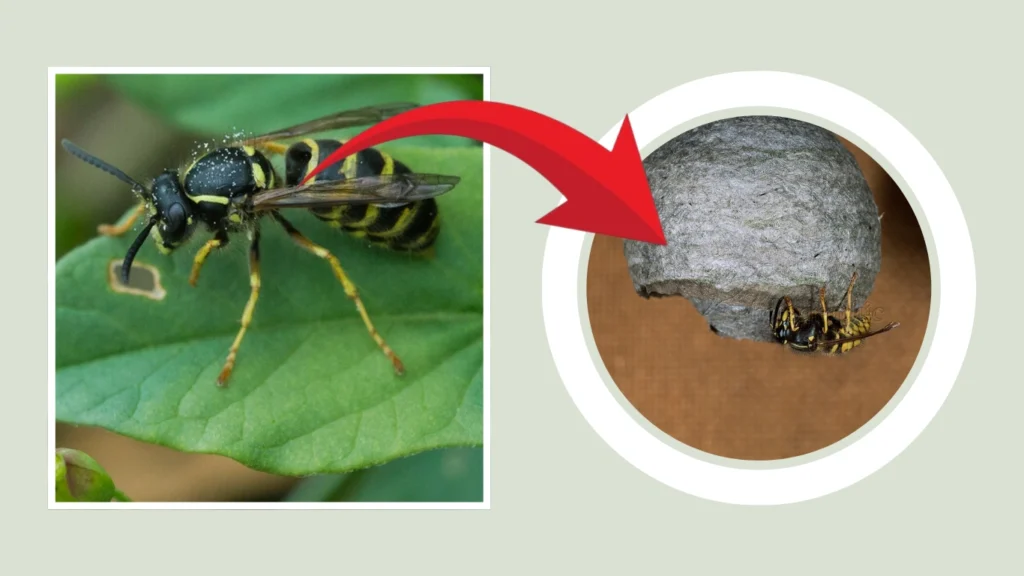
This species constructs aerial paper nests, often in bushes, trees, or attached to buildings. The nests are spherical or oval, with a single entrance at the bottom. Made from chewed wood pulp, the nest can host hundreds of individuals by mid to late summer.
Habitat
Found in gardens, parks, forests, and urban areas. Saxon wasps favor open, sheltered spots for nest-building, including sheds, balconies, and roof eaves. They adapt well to human-altered environments.
Behavior
These wasps are moderately aggressive and will defend their nest if disturbed. Workers forage for insects to feed larvae and also consume nectar, fruit juices, and sweet substances. They are especially active in summer and may become a nuisance around food.
Reproduction & Lifecycle
A queen starts the nest in spring and produces the first batch of workers. The colony grows rapidly through summer. In late summer, males and new queens are produced. The colony collapses in autumn, and only the mated queens overwinter.
37. Cynips quercusfolii
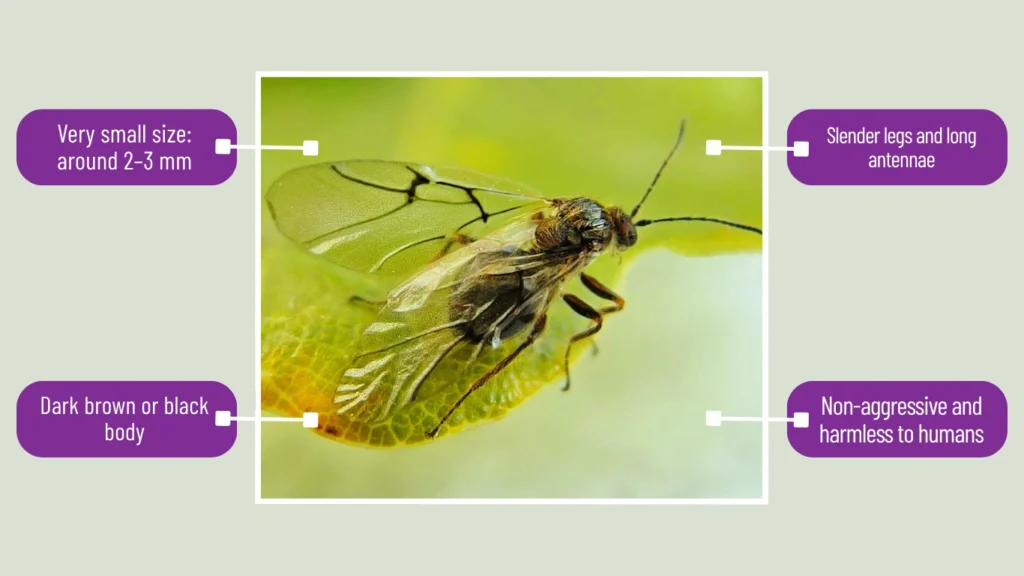
Cynips quercusfolii is a species of gall wasp that induces the growth of colorful galls on oak leaves. These galls, known as spangle galls, are disc-shaped and often reddish or yellowish, making them easy to identify in late summer.
Identification
- Very small size: around 2–3 mm
- Dark brown or black body
- Slender legs and long antennae
- Rarely seen as adults—better known by the galls they produce
- Non-aggressive and harmless to humans
Nest
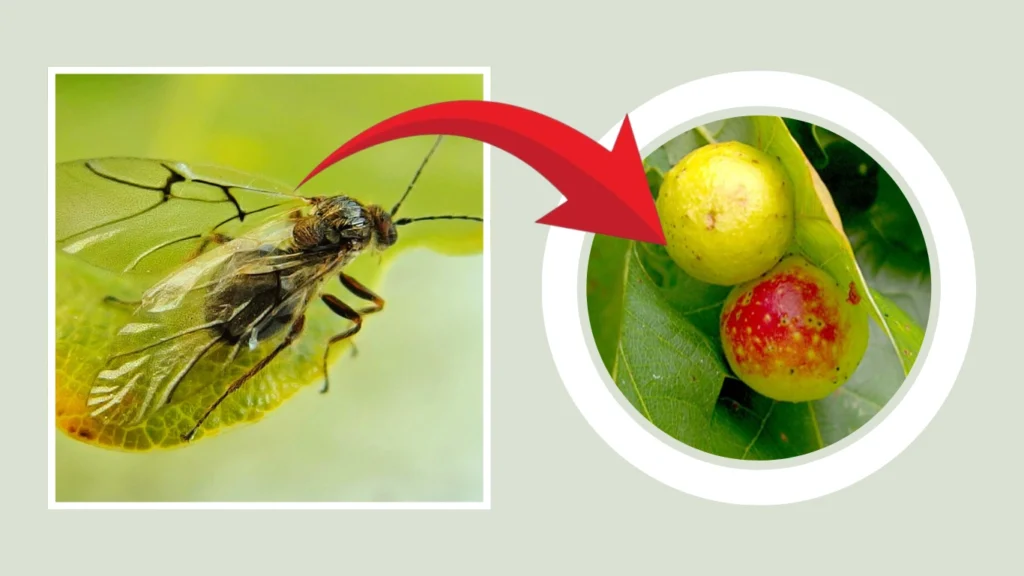
This wasp does not build a physical nest. Instead, the female lays her eggs in oak leaf tissue. The developing larvae induce the tree to form disc-shaped galls, which serve as protective shelters and food sources for the larvae inside.
Habitat
Primarily found on oak trees across Europe, especially English oak (Quercus robur). Spangle galls are most visible on the underside of leaves in late summer and autumn. The species prefers temperate woodland and forest environments.
Behavior
Cynips quercusfolii is a solitary, non-aggressive parasitic wasp. Females deposit eggs with precision into young leaf tissue. The larval activity stimulates gall formation, which can contain a single larva or sometimes multiple individuals.
Reproduction & Lifecycle
The female lays eggs in spring or early summer. Larvae develop inside the galls, feeding on plant tissue. After overwintering in the gall, adults emerge in spring to continue the cycle. This species alternates between sexual and asexual generations each year.
